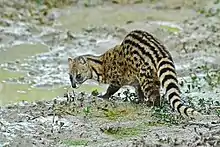List of carnivorans
Carnivora is an order of placental mammals that have specialized in primarily eating flesh. Members of this family are called carnivorans, or colloquially carnivores, though the term more properly refers to any meat-eating organisms, and some carnivoran species are omnivores or herbivores. The order Carnivora is the fifth largest order of mammals and currently comprises 285 extant species, which are grouped into 129 genera. Carnivora can be divided into two subclades: the cat-like Feliformia and the dog-like Caniformia, which are differentiated based on the structure of their ear bones and cranial features. The majority of feliform species are found in the Old World, though the cats have successfully diversified into the Americas. Members of the caniformia group are found worldwide. Carnivorans live on every major landmass and in a variety of habitats, including polar regions, hyper-arid deserts, and the open seas. They come in a wide array of different body plans in contrasting shapes and sizes, ranging from the 17 cm (7 in) least weasel to the 6 m (20 ft) and 3,700 kg (8,200 lb) male southern elephant seal. Some carnivorans, such as cats, dogs, and the ferret subspecies of the European polecat, have been domesticated, resulting in a worldwide distribution of cats and dogs.
The feliforms are further subdivided into seven families: Eupleridae, Felidae, Herpestidae, Hyaenidae, Nandiniidae, Prionodontinae, and Viverridae, and include the cats, the hyenas, the mongooses and the viverrids, among others. The caniforms are divided into nine families: Ailuridae, Canidae, Mephitidae, Mustelidae, Odobenidae, Otariidae, Phocidae, Procyonidae, and Ursidae, and include the dogs, bears, raccoons, weasels, and pinnipeds. The exact organization of the species is not fixed, with many recent proposals made based on molecular phylogenetic analysis, including smaller re-categorizations such as promoting the black mongoose subspecies of the slender mongoose to a full species, as well larger changes such as formally recognizing the family Eupleridae in 2003. In addition to the extant species, five species have gone extinct since 1500 CE: the Falkland Islands wolf and South American fox in Canidae, the sea mink in Mustelidae, the Japanese sea lion in Otariidae, and the Caribbean monk seal in Phocidae.
Conventions
Range maps are provided wherever possible; if a range map is not available, a description of the collective range of species in that genera is provided. Ranges are based on the International Union for Conservation of Nature (IUCN) Red List of Threatened Species unless otherwise noted. All extinct genera or species listed alongside extant species went extinct after 1500 CE, and are indicated by a dagger symbol "![]() ".
".
Classification
The order Carnivora consists of 285 extant species belonging to 129 genera as well the extinct genus Dusicyon, comprising two extinct species, and 3 other extinct species, which are the only carnivoran species to go extinct since prehistoric times. This does not include hybrid species (such as wolfdogs or ligers) or extinct prehistoric species. Modern molecular studies indicate that the 129 genera can be grouped into 16 families, split into the caniformia and feliformia clades, and several of these families are subdivided into named subfamilies. Three families of semi-aquatic animals, Odobenidae, Otariidae, and Phocidae, are collected into the suborder Pinnipedia.
Suborder Caniformia
- Family Ailuridae (red panda): 1 genus, 1 species
- Family Canidae
- Subfamily Caninae (wolves and foxes): 14 genera, 37 species
- Family Mephitidae (skunks and stink badgers): 4 genera, 12 species
- Family Mustelidae
- Subfamily Guloninae (martens and wolverines): 4 genera, 10 species
- Subfamily Helictidinae (ferret-badgers): 1 genus, 5 species
- Subfamily Ictonychinae (African polecats and grisons): 5 genera, 7 species
- Subfamily Lutrinae (otters): 7 genera, 12 species
- Subfamily Melinae (Eurasian badgers): 2 genera, 4 species
- Subfamily Mellivorinae (honey badger): 1 genus, 1 species
- Subfamily Mustelinae (weasels and minks): 2 genera, 19 species
- Subfamily Taxidiinae (American badger): 1 genus, 1 species
- Clade Pinnipedia
- Family Odobenidae (walrus): 1 genus, 1 species
- Family Otariidae (eared seals): 7 genera, 16 species
- Family Phocidae (true seals): 14 genera, 19 species
- Family Procyonidae (raccoons, coatis, olingos, kinkajous): 6 genera, 14 species
- Family Ursidae
- Subfamily Ailuropodinae (panda bears): 1 genus, 1 species
- Subfamily Tremarctinae (short-faced bears): 1 genus, 1 species
- Subfamily Ursinae (bears): 3 genera, 6 species
Suborder Feliformia
- Family Eupleridae
- Subfamily Euplerinae (civet-like euplerids): 3 genera, 4 species
- Subfamily Galidiinae (mongoose-like euplerids): 4 genera, 6 species
- Family Felidae
- Subfamily Felinae (small and medium-sized cats): 12 genera, 34 species
- Subfamily Pantherinae (large cats): 2 genera, 7 species
- Family Herpestidae
- Subfamily Herpestinae (European/Asian mongooses): 8 genera, 23 species
- Subfamily Mungotinae (African mongooses): 6 genera, 11 species
- Family Hyaenidae (hyaenas): 3 genera, 4 species
- Family Nandiniidae (African palm civet): 1 genus, 1 species
- Family Prionodontinae (Asiatic linsangs): 1 genus, 2 species
- Family Viverridae
- Subfamily Genettinae (genets): 2 genera, 16 species
- Subfamily Hemigalinae (Southeast Asian civets): 4 genera, 4 species
- Subfamily Paradoxurinae (Asian civets): 5 genera, 7 species
- Subfamily Viverrinae (civets): 3 genera, 6 species
Carnivorans
The following classification is based on the taxonomy described by Mammal Species of the World (2005), with augmentation by generally accepted proposals made since using molecular phylogenetic analysis, such as the promotion of the Prionodontinae subfamily of Viverridae into its own family, reclassifying several groups of Mustelidae as subfamilies, and splitting the monk seal genus Monachus into Monachus and Neomonachus.
Ailuridae
The Ailuridae family is composed of a single extant species, the red panda.
| Name | Authority and species | Range | Size and ecology |
|---|---|---|---|
| Ailurus
|
F. Cuvier, 1825
One species
|
Eastern Himalayas and southwestern China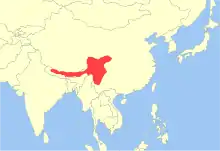 |
Size range: 50–64 cm (20–25 in) long, plus 28–59 cm (11–23 in) tail[1]
Habitats: Forest and shrubland[2] Diets: Primarily eats bamboo, as well as fruit, vegetation, lichen, bird eggs, and insects[2] |
Canidae
Members of the Canidae family are canids, and include domestic dogs, wolves, coyotes, foxes, jackals, and dingoes, among others. Canidae comprises 37 extant species, divided into 14 genera and placed inside a single extant subfamily, Caninae. Caninae is split into two tribes: Canini, comprising the wolf-like canids, and Vulpini, the fox-like canids.
| Name | Authority and species | Range | Size and ecology |
|---|---|---|---|
| Atelocynus
|
Cabrera, 1940
One species
|
Western Amazon rainforest in South America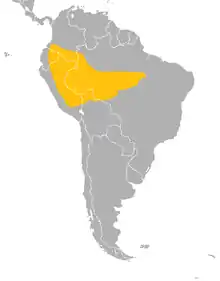 |
Size range: 72–100 cm (28–39 in) long, plus 24–35 cm (9–14 in) tail[3]
Habitats: Wetlands, forest, and savanna[4] Diets: Primarily eats fish, insects, and small mammals, as well as fruit, birds, and crabs[4][5] |
| Canis
|
Linnaeus, 1758
Five species
|
North America, Europe, Asia, and northern Africa, in addition to worldwide distribution of domestic dog |
Size range: 60 cm (24 in) long, plus 20 cm (8 in) tail (Golden jackal) to 160 cm (63 in) long, plus 50 cm (20 in) tail (Wolf)[6]
Habitats: Forest, desert, shrubland, grassland, savanna, inland wetlands, and rocky areas[7] Diets: Eats a wide variety of foods, including small to large mammals, birds, fish, fruit, carrion, and insects[7] |
| Cerdocyon
|
C. E. H. Smith, 1839
One species
|
Eastern and northern South America |
Size range: 64 cm (25 in) long, plus 28 cm (11 in) tail[8]
Habitats: Forest, savanna, shrubland, grassland, and inland wetlands[9] Diets: Primarily eats crabs and insects, as well as rodents, birds, turtles, eggs, fruit, and carrion[8][9] |
| Chrysocyon
|
C. E. H. Smith, 1839
One species
|
Central South America |
Size range: 100–130 cm (39–51 in) long, plus 45 cm (18 in) tail[10][11]
Habitats: Forest, wetlands, grassland, shrubland, and savanna[12] Diets: Primarily eats fruit, arthropods, and small and medium vertebrates[12] |
| Cuon
|
Hodgson, 1838
One species
|
Southeast Asia |
Size range: 90 cm (35 in) long, plus 40–45 cm (16–18 in) tail[13]
Habitats: Forest, grassland, and shrubland[14] Diets: Primarily eats ungulates, as well as small rodents and hares[14] |
| Dusicyon
|
C. E. H. Smith, 1839
Two species
|
Southern South America | Size range: Unknown
Habitats: Grassland and shrubland[15] Diets: Unknown |
| Lupulella
|
Hilzheimer, 1906
Two species
|
Sub-Saharan Africa | Size range: 60 cm (24 in) long, plus 16 cm (6 in) tail (Black-backed jackal) to 81 cm (32 in) long, plus 41 cm (16 in) tail (Side-striped jackal)[16]
Habitats: Forest, shrubland, savanna, grassland, inland wetlands, desert, and intertidal marine[17] Diets: Primarily eats small to medium-sized mammals, birds, and fruit, as well as insects, grass, and carrion[17] |
| Lycalopex (South American fox)
|
Burmeister, 1854
Six species
|
South America | Size range: 44 cm (17 in) long, plus 18 cm (7 in) tail (Darwin's fox) to 132 cm (52 in) long, plus 41 cm (16 in) tail (Culpeo)[18]
Habitats: Forest, rocky areas, grassland, shrubland, savanna, and desert[19] Diets: Primarily eats small mammals, birds, insects, and fruit, as well as livestock and carrion[19] |
| Lycaon
|
Brookes, 1827
One species
|
Scattered areas of Africa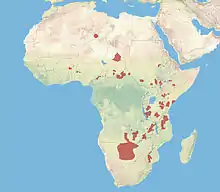 |
Size range: 76–112 cm (30–44 in) long, plus 30–42 cm (12–17 in) tail[20]
Habitats: Forest, grassland, shrubland, savanna, and desert[21] Diets: Primarily eats medium-sized antelope[21] |
| Nyctereutes
|
Temminck, 1839
One species
|
Eastern Asia, introduced to Central and Eastern Europe |
Size range: 49–71 cm (19–28 in) long, plus 15–23 cm (6–9 in) tail[20]
Habitats: Forest, grassland, and shrubland[22] Diets: Primarily eats insects, rodents, amphibians, birds, fish, and reptiles, as well as fruit, nuts, and berries[22] |
| Otocyon
|
Müller, 1835
One species
|
Southern and Eastern Africa |
Size range: 46–61 cm (18–24 in) long, plus 23–34 cm (9–13 in) tail[20]
Habitats: Grassland, shrubland, and savanna[23] Diets: Primarily eats harvester termites as well as other arthropods[23] |
| Speothos
|
Lund, 1839
One species
|
Northern South America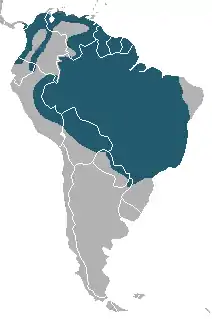 |
Size range: 57–75 cm (22–30 in) long, plus 12–15 cm (5–6 in) tail[24]
Habitats: Shrubland, forest, grassland, and savanna[25] Diets: Primarily eats small and medium mammals, as well as birds, reptiles, and fruit[25] |
| Urocyon
|
Baird, 1857
Two species
|
North America and Central America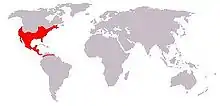 |
Size range: 46 cm (18 in) long, plus 12 cm (5 in) tail (Island fox) to 66 cm (26 in) long, plus 44 cm (17 in) tail (Gray fox)[20]
Habitats: Forest, grassland, shrubland, and intertidal marine[26] Diets: Primarily eats small mammals, fruit, insects, birds, eggs, crabs, and lizards[26] |
| Vulpes (true fox)
|
Frisch, 1775
Twelve species
|
North America, Europe, Asia, Africa, and Australia | Size range: 33 cm (13 in) long, plus 13 cm (5 in) tail (Fennec fox) to 75 cm (30 in) long, plus 43 cm (17 in) tail (Arctic fox)[27]
Habitats: Shrubland, grassland, inland wetlands, forest, desert, rocky areas, savanna, desert, and coastal marine[28] Diets: Primarily eats small mammals, reptiles, birds, and insects, as well as fish, fruit, berries, and succulents[28] |
Mephitidae
Members of the Mephitidae family are mephetids, and include the skunks and stink badgers. Mephitidae comprises twelve extant species, divided into four genera, and is not split into subfamilies.
| Name | Authority and species | Range | Size and ecology |
|---|---|---|---|
| Conepatus (hog-nosed skunk)
|
Gray, 1837
Four species
|
Southern North America and South America |
Size range: 20 cm (8 in) long, plus 13 cm (5 in) tail (Molina's hog-nosed skunk) to 51 cm (20 in) long, plus 41 cm (16 in) tail (American hog-nosed skunk)[29]
Habitats: Shrubland, grassland, savanna, forest, and rocky areas[30] Diets: Omnivorous; primarily eats invertebrates, rodents, small reptiles, and eggs[30] |
| Mephitis (skunk)
|
Geoffroy, 1795
Two species
|
North America |
Size range: 19 cm (7 in) long, plus 35 cm (14 in) tail (Hooded skunk) to 82 cm (32 in) long, plus 40 cm (16 in) tail (Striped skunk)[31]
Habitats: Desert, shrubland, rocky areas, grassland, savanna, and forest[32] Diets: Primarily eats insects, fruit, small vertebrates, vegetation, and bird eggs[32] |
| Mydaus (stink badger)
|
F. Cuvier, 1821
Two species
|
Western Philippines, Indonesia, and Malaysia |
Size range: 32 cm (13 in) long, plus 1 cm (0 in) tail (Palawan stink badger) to 51 cm (20 in) long, plus 8 cm (3 in) tail (Sunda stink badger)[33]
Habitats: Forest, shrubland, grassland, and introduced vegetation[34] Diets: Primarily eats birds' eggs, carrion, insects, worms, arthropods, and plants[34] |
| Spilogale (spotted skunk)
|
Gray, 1865
Four species
|
North America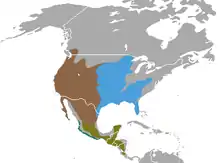 |
Size range: 11 cm (4 in) long, plus 7 cm (3 in) tail (Pygmy spotted skunk) to 37 cm (15 in) long, plus 21 cm (8 in) tail (Western spotted skunk)[35]
Habitats: Inland wetlands, grassland, shrubland, rocky areas, savanna, and forest, rocky areas, marine coastal/supratidal[36] Diets: Omnivorous; primarily eats invertebrates, small mammals, fruit, grain, birds, carrion, and bird eggs[36] |
Mustelidae
Members of the Mustelidae family are mustelids, and are composed of weasels, badgers, otters, ferrets, martens, minks, and wolverines, among others. Mustelidae is the largest family in Carnivora, and comprises 59 extant species, divided into 23 genera. These genera are split into 8 subfamilies: Guloninae, martens and wolverines; Helictidinae, ferret-badgers; Ictonychinae, African polecats and grisons; Lutrinae, otters; Melinae, Eurasian badgers; Mellivorinae, the honey badger; Mustelinae, weasels and minks; and Taxidiinae, the American badger.
| Name | Authority and species | Range | Size and ecology |
|---|---|---|---|
| Eira
|
Hamilton Smith, 1842
One species
|
Central America and northern South America |
Size range: 60–70 cm (24–28 in) long, plus 35–45 cm (14–18 in) tail[37]
Habitats: Forest and savanna[38] Diets: Primarily eats fruit, carrion, small vertebrates, insects, and honey[38] |
| Gulo
|
Pallas, 1780
One species
|
Arctic North America, Europe, and Asia |
Size range: 70–105 cm (28–41 in) long, plus 18–26 cm (7–10 in) tail[39]
Habitats: Rocky areas, shrubland, forest, and grassland[40] Diets: Primarily eats carrion and small to large mammals[40] |
| Martes (marten)
|
Pinel, 1792
Seven species
|
Northern North America, Europe, and Asia |
Size range: 38 cm (15 in) long, plus 9 cm (4 in) tail (Sable) to 72 cm (28 in) long, plus 48 cm (19 in) tail (Yellow-throated marten)[41]
Habitats: Forest, grassland, rocky areas, and shrubland[42] Diets: Primarily eats rodents and small mammals, as well as birds, amphibians, insects, fruit, berries, and carrion[42] |
| Pekania
|
Gray, 1865
One species
|
Northern North America |
Size range: 75–120 cm (30–47 in) long, plus 31–41 cm (12–16 in) tail[43]
Habitats: Forest[44] Diets: Primarily eats small to medium mammals, birds, and carrion[44] |
| Name | Authority and species | Range | Size and ecology |
|---|---|---|---|
| Melogale (ferret-badger)
|
I. Saint-Hilaire, 1831
Five species
|
East and Southeast Asia | Size range: 30 cm (12 in) long, plus 15 cm (6 in) tail (Chinese ferret-badger) to 44 cm (17 in) long, plus 23 cm (9 in) tail (Bornean ferret-badger, Burmese ferret-badger)[45]
Habitats: Forest, shrubland, and grassland[46] Diets: Primarily eats invertebrates, amphibians, insects, fruit, and carrion[46] |
| Name | Authority and species | Range | Size and ecology |
|---|---|---|---|
| Galictis (grison)
|
Bell, 1826
Two species
|
South America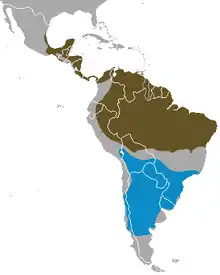 |
Size range: 28 cm (11 in) long, plus 12 cm (5 in) tail (Lesser grison) to 76 cm (30 in) long, plus 30 cm (12 in) tail (Greater grison)[47]
Habitats: Inland wetlands, forest, grassland, and savanna[48] Diets: Primarily eats small mammals, birds, lizards, amphibians, eggs, and fruit[48] |
| Ictonyx (striped polecat)
|
Kaup, 1835
Two species
|
Africa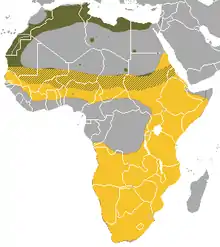 |
Size range: 28 cm (11 in) long, plus 20 cm (8 in) tail (Striped polecat) to 47 cm (19 in) long, plus 19 cm (7 in) tail (Saharan striped polecat)[49]
Habitats: Grassland, savanna, desert, and shrubland[50] Diets: Primarily eats rodents, small mammals, birds, fish, and insects[50] |
| Lyncodon
|
Gervais, 1845
One species
|
Argentina |
Size range: 30–35 cm (12–14 in) long, plus 6–9 cm (2–4 in) tail[51]
Habitats: Shrubland, grassland, and forest[52] Diets: Primarily eats rodents and birds[52] |
| Poecilogale
|
Thomas, 1883
One species
|
Southern Africa |
Size range: 25–36 cm (10–14 in) long, plus 13–23 cm (5–9 in) tail[53]
Habitats: Shrubland, forest, savanna, and grassland[54] Diets: Primarily eats small mammals, rodents, and birds, as well as snakes and insects[53][54] |
| Vormela
|
Blasius, 1884
One species
|
Southeast Europe and central Asia |
Size range: 28–48 cm (11–19 in) long, plus 14–20 cm (6–8 in) tail[55]
Habitats: Desert, rocky areas, grassland, and shrubland[56] Diets: Primarily eats rodents and birds[56] |
| Name | Authority and species | Range | Size and ecology |
|---|---|---|---|
| Aonyx
|
Lesson, 1827
Two species
|
Sub-Saharan Africa and Southeast Asia | Size range: 40 cm (16 in) long, plus 25 cm (10 in) tail (Asian small-clawed otter) to 95 cm (37 in) long, plus 60 cm (24 in) tail (African clawless otter)[57]
Habitats: Intertidal marine, coastal marine, inland wetlands, forest, shrubland, neritic marine, and grassland[58] Diets: Primarily eats crabs, molluscs, insects, and small fish, as well as rodents, snakes, and amphibians[58] |
| Enhydra
|
Fleming, 1828
One species
|
Western North American coast, eastern Russian coast, northern Japanese coast |
Size range: 55–130 cm (22–51 in) long, plus 12–33 cm (5–13 in) tail[59]
Habitats: Neritic marine and oceanic marine[60] Diets: Primarily eats marine invertebrates, as well as fish[60] |
| Hydrictis
|
Pocock, 1921
One species
|
Much of sub-Saharan Africa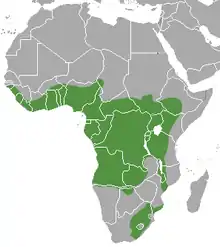 |
Size range: 57–69 cm (22–27 in) long, plus 33–44 cm (13–17 in) tail[61]
Habitats: Inland wetlands, neritic marine, forest, coastal marine, and intertidal marine[62] Diets: Primarily eats frogs, crabs and small water birds[61][62] |
| Lontra
|
Gray, 1843
Four species
|
North and South America |
Size range: 50 cm (20 in) long, plus 37 cm (15 in) tail (Neotropical otter) to 107 cm (42 in) long, plus 46 cm (18 in) tail (North American river otter)[63]
Habitats: Inland wetlands, coastal marine, neritic marine, intertidal marine, and oceanic marine[64] Diets: Primarily eats fish, crustaceans, and molluscs, as well as insects, amphibians, and birds[64] |
| Lutra
|
Brisson, 1762
Two species
|
Europe, Asia, North Africa |
Size range: 50 cm (20 in) long, plus 35 cm (14 in) tail (Hairy-nosed otter) to 70 cm (28 in) long, plus 40 cm (16 in) tail (Eurasian otter)[65]
Habitats: Inland wetlands, forest, grassland, coastal marine, neretic marine, intertidal marine, and shrubland[66] Diets: Primarily eats fish, as well as insects, reptiles, amphibians, birds, small mammals, and crustaceans[66] |
| Lutrogale
|
Gray, 1865
One species
|
South and southeast Asia |
Size range: 65–79 cm (26–31 in) long, plus 40–50 cm (16–20 in) tail[67]
Habitats: Inland wetlands, forest, grassland, coastal marine, neritic marine, intertidal marine, and shrubland[68] Diets: Primarily eats fish, as well as shrimp, crabs, and insects[68] |
| Pteronura
|
Gray, 1837
One species
|
North and central South America |
Size range: 96–123 cm (38–48 in) long, plus 45–65 cm (18–26 in) tail[69]
Habitats: Inland wetlands, coastal marine, neritic marine, and forest[70] Diets: Primarily eats fish, as well as caiman and turtles[70] |
| Name | Authority and species | Range | Size and ecology |
|---|---|---|---|
| Arctonyx
|
F.Cuvier, 1825
One species
|
East and southeast Asia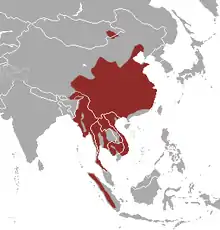 |
Size range: 55–70 cm (22–28 in) long, plus 12–17 cm (5–7 in) tail[71]
Habitats: Forest, grassland, shrubland, and savanna[72] Diets: Believed to primarily eat worms[72] |
| Meles
|
Brisson, 1762
Three species
|
Europe and Asia |
Size range: 49 cm (19 in) long, plus 13 cm (5 in) tail (Asian badger) to 90 cm (35 in) long, plus 20 cm (8 in) tail (European badger)[73]
Habitats: Grassland, forest, desert, and shrubland[74] Diets: Omnivorous; eats fruit, nuts, plants, earthworms, insects, eggs, carrion, and small mammals[74] |
| Name | Authority and species | Range | Size and ecology |
|---|---|---|---|
| Mellivora
|
Gottlieb Conrad Christian Storr, 1780
One species
|
Africa, Middle East, and India |
Size range: 73–96 cm (29–38 in) long, plus 14–23 cm (6–9 in) tail[75]
Habitats: Forest, shrubland, savanna, and desert[76] Diets: Primarily eats smaller mammals[76] |
| Name | Authority and species | Range | Size and ecology |
|---|---|---|---|
| Mustela (weasel)
|
Linnaeus, 1758
Seventeen species
|
North and South America, Europe, and Asia |
Size range: 11 cm (4 in) long, plus 1 cm (0 in) tail (Least weasel) to 56 cm (22 in) long, plus 18 cm (7 in) tail (Steppe polecat)[77]
Habitats: Forest, inland wetlands, rocky areas, coastal marine, shrubland, grassland, urban[78] Diets: Primarily eats small mammals, as well as fruit, earthworms, invertebrates, lizards, amphibians, fish, carrion, eggs, and birds[78] |
| Neovison
|
Baryshnikov and Abramov, 1997
Two species
|
Canada and United States, and large areas in South America, Europe, and Asia (native range in red (North America), introduced in pink) |
Size range: 31 cm (12 in) long, plus 14 cm (6 in) tail (American mink) to 91 cm (36 in) long, plus 25 cm (10 in) tail (Sea mink)[79]
Habitats: Inland wetlands, forest, and shrubland; formerly intertidal marine, neritic marine, and coastal marine[80] Diets: Primarily eats fish, amphibians, crustaceans, muskrats, and small mammals[80] |
| Name | Authority and species | Range | Size and ecology |
|---|---|---|---|
| Taxidea
|
Horsfield, 1839
One species
|
United States and southern Canada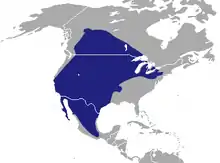 |
Size range: 42–72 cm (17–28 in) long, plus 10–16 cm (4–6 in) tail[81]
Habitats: Forest, grassland, and shrubland[82] Diets: Primarily eats fossorial rodents, as well as scorpions, insects, snakes, lizards, and birds[82] |
Clade Pinnipedia
Pinnipedia is an infraorder of carnivores, composed of seals, sea lions, and the walrus. A member of this group is called a pinniped or a seal. The clade contains three families: Odobenidae, comprising the walrus; Otariidae, the eared seals, split between the sea lions and fur seals; and Phocidae, the earless or true seals. Odobenidae and Otariidae are combined into the superfamily Otarioidea, with Phocidae in Phocoidea. These families are not subdivided into subfamilies.
Odobenidae
The Odobenidae family is composed of a single extant species, the Walrus.
| Name | Authority and species | Range | Size and ecology |
|---|---|---|---|
| Odobenus
|
Brisson, 1762
One species
|
Arctic Ocean and subarctic seas |
Size range: Male: 270–356 cm (106–140 in) long; 800–1,700 kg (1,764–3,748 lb) Female: 225–312 cm (89–123 in) long; 400–1,250 kg (882–2,756 lb)[83] Habitats: Neritic marine, oceanic marine, intertidal marine, coastal marine, and other[84] Diets: Primarily eats bivalve mollusks, as well as other invertebrates, slow-moving fish, and occasionally birds, seals, and other marine mammals[84] |
Otariidae
Members of the Otariidae family are otariids, or colloquially eared seals. There are sixteen species of sea lions and fur seals in Otariidae, divided into seven genera.
| Name | Authority and species | Range | Size and ecology |
|---|---|---|---|
| Arctocephalus
|
Geoffroy, F. Cuvier, 1826
Eight species
|
Antarctic Ocean and southern seas and coasts |
Size range: 100 cm (39 in) long and 30 kg (66 lb) (New Zealand fur seal females) to 227 cm (89 in) long and 360 kg (794 lb) (Brown fur seal males)[85]
Habitats: Forest, shrubland, neritic marine, oceanic marine, intertidal marine, and coastal marine[86] Diets: Eats a wide variety of cephalopods, fish, and birds, and some penguins[86] |
| Callorhinus
|
Gray, 1859
One species
|
Northern Pacific Ocean (dark blue indicates breeding grounds) |
Size range: Male: 213 cm (84 in) long; 180–275 kg (397–606 lb) Female: 142 cm (56 in) long; 40–50 kg (88–110 lb)[87] Habitats: Neritic marine, oceanic marine, intertidal marine, and coastal marine[87] Diets: Eats a variety of epipelagic and vertically migrating mesopelagic fish and squid[87] |
| Eumetopias
|
Gill, 1866
One species
|
Northern Pacific Ocean (red indicates breeding grounds) |
Size range: Male: 300–340 cm (118–134 in) long; 1,120 kg (2,469 lb) Female: 230–290 cm (91–114 in) long; 350 kg (772 lb)[88] Habitats: Neritic marine, oceanic marine, intertidal marine, and coastal marine[89] Diets: Eats a variety of fish and cephalopods, as well as northern fur seal, harbor seals, and ringed seals[89] |
| Neophoca
|
Gray, 1866
One species
|
Southwestern Australian coast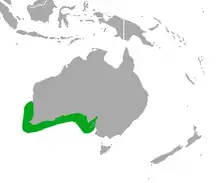 |
Size range: Male: 180–250 cm (71–98 in) long; 180–250 kg (397–551 lb) Female: 130–180 cm (51–71 in) long; 61–105 kg (134–231 lb)[90] Habitats: Neritic marine, oceanic marine, intertidal marine, and coastal marine[90] Diets: Eats cephalopods, fish, and crustaceans[90] |
| Otaria
|
Péron, 1816
One species
|
Southern and western South American coast |
Size range: Male: 210–260 cm (83–102 in) long; 300–350 kg (661–772 lb) Female: 150–200 cm (59–79 in) long; 170 kg (375 lb)[91] Habitats: Inland wetlands, neritic marine, oceanic marine, intertidal marine, and coastal marine[91] Diets: Eats a wide variety of benthic fish, pelagic fish, and invertebrates[91] |
| Phocarctos
|
Peters, 1866
One species
|
Southern New Zealand coast and islands |
Size range: Male: 210–270 cm (83–106 in) long; 300–450 kg (661–992 lb) Female: 180–200 cm (71–79 in) long; 90–165 kg (198–364 lb)[92] Habitats: Forest, shrubland, neritic marine, oceanic marine, intertidal marine, and coastal marine[92] Diets: Eats a wide variety of fish, cephalopods, and crustaceans, as well as penguins[92] |
| Zalophus
|
Gill, 1866
Three species
|
Pacific North American coast and Galápagos Islands |
Size range: 160 cm (63 in) long and 275 kg (606 lb) (California sea lion) to 250 cm (98 in) long and 560 kg (1,235 lb) (Japanese sea lion males)[93]
Habitats: Neritic marine, oceanic marine, intertidal marine, and coastal marine[94] Diets: Eats a variety of fish and squid[94] |
Phocidae
Members of the Phocidae family are phocids, or colloquially earless or true seals. There are nineteen species of seals in Phocidae, divided into fourteen genera.
| Name | Authority and species | Range | Size and ecology |
|---|---|---|---|
| Cystophora
|
Agardh, 1841
One species
|
Central and western North Atlantic ocean (blue indicates breeding grounds) |
Size range: Male: 250–270 cm (98–106 in) long; 200–400 kg (441–882 lb) Female: 200–220 cm (79–87 in) long; 145–300 kg (320–661 lb)[83] Habitats: Neritic marine, oceanic marine, intertidal marine, and coastal marine[95] Diets: Preys on fish and invertebrates throughout the water column[95] |
| Erignathus
|
Gill, 1866
One species
|
Arctic ocean |
Size range: 200–260 cm (79–102 in) long; 200–360 kg (441–794 lb) tail[83]
Habitats: Neritic marine, oceanic marine, and intertidal marine[96] Diets: Primarily eats crabs, shrimp, clams, snails, benthic and demersal fish, and spoon worms[96] |
| Halichoerus
|
Nilsson, 1820
One species
|
Shores of the North Atlantic Ocean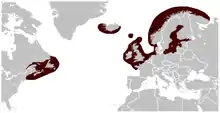 |
Size range: Male: 195–230 cm (77–91 in) long; 170–310 kg (375–683 lb) Female: 165–195 cm (65–77 in) long; 105–186 kg (231–410 lb)[83] Habitats: Neritic marine, oceanic marine, intertidal marine, and coastal marine[97] Diets: Primarily eats benthic and demersal fish[97] |
| Histriophoca
|
Gill, 1873
One species
|
Arctic and subarctic regions of the North Pacific Ocean (blue indicates reduced summer range)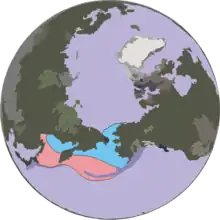 |
Size range: 165–175 cm (65–69 in) long; 72–90 kg (159–198 lb)[98]
Habitats: Neritic marine and oceanic marine[99] Diets: Preys on fish, crustaceans, and other invertebrates[99] |
| Hydrurga
|
Gistel, 1848
One species
|
Antarctic Ocean |
Size range: Male: 250–320 cm (98–126 in) long; 200–455 kg (441–1,003 lb) Female: 241–338 cm (95–133 in) long; 225–591 kg (496–1,303 lb)[83] Habitats: Neritic marine, oceanic marine, intertidal marine, and coastal marine[100] Diets: Primarily eats krill, fish, squid, penguins, other seabirds, and juvenile seals[100] |
| Leptonychotes
|
Gill, 1872
One species
|
Coastal Antarctic Ocean |
Size range: 280–330 cm (110–130 in) long; 400–600 kg (882–1,323 lb)[101]
Habitats: Neritic marine, oceanic marine, intertidal marine, and coastal marine[102] Diets: Primarily eats cod icefish, as well as Antarctic toothfish, lanternfish, and cephalopods[102] |
| Lobodon
|
Gray, 1844
One species
|
Antarctic Ocean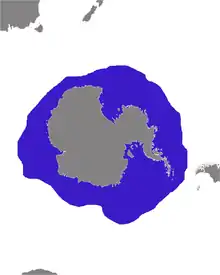 |
Size range: Male: 203–241 cm (80–95 in) long; 200–300 kg (441–661 lb) Female: 216–241 cm (85–95 in) long; 200–300 kg (441–661 lb)[83] Habitats: Neritic marine, oceanic marine, intertidal marine, and coastal marine[103] Diets: Primarily eats Antarctic krill, as well as fish and squid[103] |
| Mirounga (elephant seal)
|
Gray, 1827
Two species
|
Antarctic Ocean and western North American coast | Size range: 200 cm (79 in) long and 400 kg (882 lb) (Southern elephant seal females) to 600 cm (236 in) long; 3,700 kg (8,157 lb) (Southern elephant seal males)[104]
Habitats: Neritic marine, oceanic marine, intertidal marine, and coastal marine[105] Diets: Primarily eats squid, lanternfish, cod icefish, and other mesopelagic fish[105] |
| Monachus
|
Fleming, 1822
One species
|
Scattered portions of the Mediterranean Sea | Size range: 230–280 cm (91–110 in) long; 240–300 kg (529–661 lb)[106]
Habitats: Neritic marine, oceanic marine, intertidal marine, and coastal marine[107] Diets: Eats benthic fish, pelagic fish, cephalopods, and lobsters[106][107] |
| Neomonachus
|
Slater, Helgen, 2014
Two species
|
Hawaiian islands; formerly the Caribbean Sea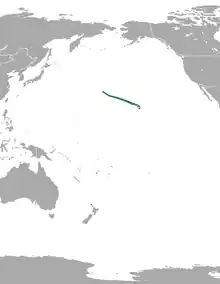 |
Size range: 200 cm (79 in) long and 200 kg (441 lb) (Caribbean monk seal) to 250 cm (98 in) long; 240 kg (529 lb) (Hawaiian monk seal)[108]
Habitats: Neritic marine, oceanic marine, intertidal marine, and coastal marine[109] Diets: Eats benthic fish, pelagic fish, cephalopods, and lobsters[109] |
| Ommatophoca
|
Gray, 1844
One species
|
Coastal Antarctic Ocean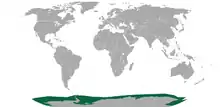 |
Size range: Male: 168–208 cm (66–82 in) long; 129–216 kg (284–476 lb) Female: 190–250 cm (75–98 in) long; 159–204 kg (351–450 lb)[83] Habitats: Neritic marine, oceanic marine, and coastal marine[110] Diets: Primarily eats squid, as well as fish and krill[110] |
| Pagophilus
|
Gray, 1844
One species
|
Northern Atlantic Ocean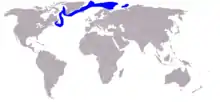 |
Size range: Male: 171–190 cm (67–75 in) long; 135 kg (298 lb) Female: 168–183 cm (66–72 in) long; 120 kg (265 lb)[111] Habitats: Neritic marine, oceanic marine, intertidal marine, and coastal marine[112] Diets: Eats a wide variety of fish and invertebrates[112] |
| Phoca
|
Linnaeus, 1758
Two species
|
Northern Hemisphere coastlines | Size range: 148 cm (58 in) long and 60 kg (132 lb) (Harbor seal females) to 186 cm (73 in) long; 170 kg (375 lb) (Harbor seal males)[113]
Habitats: Neritic marine, oceanic marine, intertidal marine, and coastal marine[114] Diets: Eats a wide variety of fish, cephalopods, and crustaceans[114] |
| Pusa
|
Scopoli, 1771
Three species
|
Arctic Ocean, Caspian Sea, and Lake Baikal | Size range: 110 cm (43 in) long and 32 kg (71 lb) (Ringed seal) to 175 cm (69 in) long; 124 kg (273 lb) (Ringed seal)[115]
Habitats: Inland wetlands, neritic marine, and oceanic marine[116] Diets: Eats a wide variety of fish and invertebrates[116] |
Procyonidae
Members of the Procyonidae family are procyonids, and are composed of raccoons, coatis, olingos, kinkajous, ring-tailed cats, and cacomistles, among others. Procyonidae comprises fourteen extant species, divided into six genera.
| Name | Authority and species | Range | Size and ecology |
|---|---|---|---|
| Bassaricyon (olingo)
|
Allen, 1876
Four species
|
Central America and northwest South America | Size range: 30 cm (12 in) long, plus 40 cm (16 in) tail (Eastern lowland olingo) to 45 cm (18 in) long, plus 53 cm (21 in) tail (Northern olingo)[117]
Habitats: Forest[118] Diets: Primarily eats fruit and nectar, as well as flowers, small rodents, lizards, birds, insects, and eggs[118] |
| Bassariscus
|
Coues, 1887
Two species
|
Central America and southern North America | Size range: 30 cm (12 in) long, plus 31 cm (12 in) tail (Ring-tailed cat) to 47 cm (19 in) long, plus 53 cm (21 in) tail (Cacomistle)[119]
Habitats: Shrubland, forest, rocky areas, desert, and grassland[120] Diets: Primarily eats fruit, insects, and small vertebrates[120] |
| Nasua (coati)
|
Storr, 1780
Two species
|
Southern North America, Central America, and South America | Size range: 33 cm (13 in) long, plus 33 cm (13 in) tail (White-nosed coati) to 67 cm (26 in) long, plus 69 cm (27 in) tail (South American coati)[121]
Habitats: Forest, grassland, and shrubland[122] Diets: Primarily eats fruit and invertebrates[122] |
| Nasuella (mountain coati)
|
Hollister, 1915
Two species
|
Andes mountains in northern South America |
Size range: 36 cm (14 in) long, plus 20 cm (8 in) tail (Western mountain coati) to 54 cm (21 in) long, plus 30 cm (12 in) tail (Eastern mountain coati)[123]
Habitats: Forest and grassland[124] Diets: Primarily eats invertebrates, small vertebrates, fruit, and vegetable remains[124] |
| Potos
|
Geoffroy Saint-Hilaire & G. Cuvier, 1795
One species
|
Central America and northern South America |
Size range: 40–60 cm (16–24 in) long, plus 40–60 cm (16–24 in) tail[125]
Habitats: Forest[126] Diets: Primarily eats fruit, as well as flowers and leaves[126] |
| Procyon (raccoon)
|
Storr, 1780
Three species
|
North and South America, and introduced to Central Europe, the Caucasus Mountains, and Japan | Size range: 41 cm (16 in) long, plus 19 cm (7 in) tail (Racoon) to 65 cm (26 in) long, plus 38 cm (15 in) tail (Crab-eating raccoon)[127]
Habitats: Forest and inland wetlands[128] Diets: Omnivorous, eats fruit, nuts, insects, small mammals, molluscs, crabs, eggs, birds, frogs, fish, aquatic invertebrates, worms, and garbage[128] |
Ursidae
Members of the Ursidae family are ursids, or colloquially bears. Ursidae comprises three extant subfamilies: the monotypic Ailuropodinae, the panda bears; Tremarctinae, the short-faced bears; and Ursinae, containing all other extant bears. There are eight extant species in Felidae, divided into five genera.
| Name | Authority and species | Range | Size and ecology |
|---|---|---|---|
| Ailuropoda
|
H. Milne-Edwards, 1870
One species
|
Central China |
Size range: 150–180 cm (59–71 in) long, plus 10–15 cm (4–6 in) tail 80–123 kg (176–271 lb)[129][130] Habitats: Forest[131] |
| Name | Authority and species | Range | Size and ecology |
|---|---|---|---|
| Tremarctos
|
Gervais, 1855
One species
|
Andes mountains in South America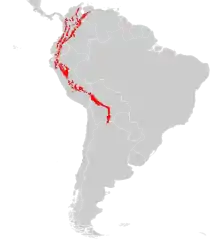 |
Size range: 120–200 cm (47–79 in) long, plus 7 cm (3 in) tail 60–175 kg (132–386 lb)[132] Habitats: Shrubland, grassland, and forest[133] Diets: Primarily eats bromeliads and palm trees, as well as cattle, other mammals, and fruit[133] |
| Name | Authority and species | Range | Size and ecology |
|---|---|---|---|
| Helarctos
|
Gervais, 1855
One species
|
Southeast Asia (current range in brown, former in black) |
Size range: 120–150 cm (47–59 in) long, plus 3–7 cm (1–3 in) tail 35–80 kg (77–176 lb)[134][135] Habitats: Forest and shrubland[136] Diets: Primarily eats termites, ants, beetle larvae, bee larvae, honey, and fruit[136] |
| Melursus
|
Meyer, 1793
One species
|
India (current range in green, former in black) |
Size range: 150–180 cm (59–71 in) long, plus 7–12 cm (3–5 in) tail 54–141 kg (119–311 lb)[137] Habitats: Shrubland, grassland, forest, and savanna[138] Diets: Primarily eats termites and fruit[138] |
| Ursus
|
Linnaeus, 1758
Four species
|
North America, Europe, Asia | Size range: 100 cm (39 in) long, plus 6 cm (2 in) tail, 80 kg (176 lb) (brown bear) to 244 cm (96 in) long, plus 13 cm (5 in) tail, 726 kg (1,601 lb) (polar bear)[139]
Habitats: North America, Europe, Asia[140] Diets: Eats vegetation, insects, fruit, nuts, mammals; polar bear primarily eats seals, as well as walruses, beluga whales, birds, fish, vegetation and kelp[140] |
Eupleridae
Members of the Eupleridae family are euplerids, or colloquially Malagasy mongooses or Malagasy carnivorans. Eupleridae comprises two extant subfamilies, the civet-like Euplerinae and the mongoose-like Galidiinae. Historically, the Euplerinae species were included in the civet family Viverridae, and several of the Galidiinae species in the mongoose family Herpestidae, but more recent genetic evidence showed them to be part of the same clade, having evolved from a single ancestor species 18–24 million years ago. There are 10 extant species in Eupleridae, divided into 7 genera.
| Name | Authority and species | Range | Size and ecology |
|---|---|---|---|
| Cryptoprocta
|
Bennett, 1833
One species
|
Madagascar |
Size range: 61–80 cm (24–31 in) long, plus 61–80 cm (24–31 in) tail[141]
Habitats: Forest[142] Diets: Primarily eats small mammals and reptiles[142] |
| Eupleres
|
Doyère, 1835
Two species
|
Eastern and northern Madagascar | Size range:
Habitats: Forest and inland wetlands[143] Diets: Primarily eats invertebrates[143] |
| Fossa
|
Gray, 1865
One species
|
Eastern Madagascar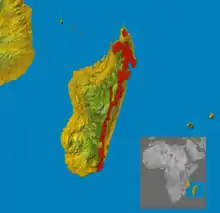 |
Size range:
Habitats: Forest[144] Diets: Primarily eats small vertebrates, insects, and bird's eggs[144] |
| Name | Authority and species | Range | Size and ecology |
|---|---|---|---|
| Galidia
|
Geoffroy, 1837
One species
|
Eastern Madagascar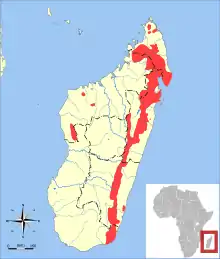 |
Size range:
Habitats: Forest[145] Diets: [145] |
| Galidictis
|
Geoffroy, 1839
Two species
|
Eastern and southern Madagascar |
Size range: [146]
Habitats: Forest and shrubland[147] Diets: [147] |
| Mungotictis
|
Pocock, 1915
One species
|
Western Madagascar |
Size range:
Habitats: Forest and shrubland[148] Diets: [148] |
| Salanoia
|
Gray, 1865
Two species
|
Northeastern Madagascar |
Size range:
Habitats: Forest and inland wetlands[149] Diets: |
Felidae
Members of the Felidae family are felids, or colloquially cats; "cat" refers both to felids in general and specifically to domestic cats. Felidae comprises two extant subfamilies, Felinae (small cats) and Pantherinae (large cats). There are 34 extant species in Felidae, divided into 14 genera.
| Name | Authority and species | Range | Size and ecology |
|---|---|---|---|
| Acinonyx
|
Brookes, 1828
One species
|
Southern Africa, central Africa, and Iran |
Size range: 113–140 cm (44–55 in) long, 60–84 cm (24–33 in) tail[150]
Habitats: Desert, grassland, savanna, and shrubland[151] Diets: Preys mainly upon antelopes and gazelles[151] |
| Caracal
|
Gray, 1843
Two species
|
Most of non-desert Africa and Middle East | Size range: 65 cm (26 in) long, plus 28 cm (11 in) tail (African golden cat) to 100 cm (39 in) long, plus 34 cm (13 in) tail (caracal)[152]
Habitats: Forest, desert, grassland, shrubland, and savanna[153] Diets: Primarily eats rodents and squirrels, along with antelope, primates, birds, reptiles, and fish[153] |
| Catopuma
|
Severtzov, 1858
Two species
|
Scattered areas of Southeast Asia | Size range: 53 cm (21 in) long, plus 32 cm (13 in) tail (bay cat) to 105 cm (41 in) long, plus 56 cm (22 in) tail (Asian golden cat)[154]
Habitats: Forest, savanna, grassland, and shrubland[155] Diets: Mostly unknown, with evidence of preying on rodents, squirrels, and snakes[155] |
| Felis
|
Linnaeus, 1758
Seven species
|
Africa, Europe, and Asia (excluding worldwide domestic cat) |
Size range: 37 cm (15 in) long, plus 14 cm (6 in) tail (black-footed cat) to 85 cm (33 in) long, plus 35 cm (14 in) tail (Chinese mountain cat)[156]
Habitats: Forest, desert, shrubland, savanna, grassland, and inland wetlands, plus cosmopolitan distribution of feral domestic cats[157] Diets: Primarily eats birds and small mammals, as well as other small animals[157] |
| Herpailurus
|
Saint-Hilaire, 1803
One species
|
Most of South and Central America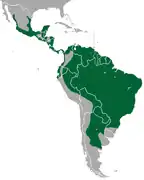 |
Size range: 49–78 cm (19–31 in) long, 28–59 cm (11–23 in) tail[158]
Habitats: Grassland, shrubland, savanna, and forest[159] Diets: Primarily preys on small mammals, birds and reptiles[159] |
| Leopardus
|
Gray, 1842
Eight species
|
South and Central America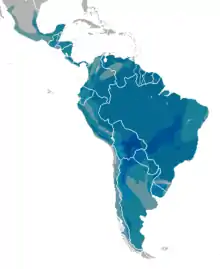 |
Size range: 37 cm (15 in) long, plus20 cm (8 in) tail (kodkod) to 102 cm (40 in) long, plus 50 cm (20 in) tail (ocelot)[160]
Habitats: Savanna, forest, shrubland, grassland, rocky areas, and desert[161] Diets: Primarily eats small and medium mammals, birds and reptiles, as well as carrion[161] |
| Leptailurus
|
Severtzov, 1858
One species
|
Non-rainforest sub-Saharan Africa |
Size range: 59–100 cm (23–39 in) long, 20–38 cm (8–15 in) tail[162]
Habitats: Grassland, inland wetlands, forest, and savanna[163] Diets: Primarily eats small mammals and rodents, as well as birds, reptiles, and arthropods[163] |
| Lynx
|
Kerr, 1792
Four species
|
North America, northern Europe, and northern and central Asia |
Size range: 80 cm (31 in) long, plus9 cm (4 in) tail (bobcat) to 120 cm (47 in) long, plus 23 cm (9 in) tail (Eurasian lynx)[164]
Habitats: Desert, shrubland, savanna, forest, rocky areas, and grassland[165] Diets: Primarily eats rabbits and hares, along with rodents, birds, deer, and small or medium-sized mammals[165] |
| Otocolobus
|
Brandt, 1841
One species
|
Central Asia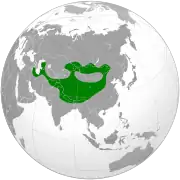 |
Size range: 46–65 cm (18–26 in) long, 21–31 cm (8–12 in) tail[166]
Habitats: Rocky areas, grassland, shrubland, and desert[167] Diets: Preys primarily on small mammals, especially pikas, as well as rodents and birds[167] |
| Pardofelis
|
Severtzov, 1858
One species
|
Parts of Southeast Asia |
Size range: 45–62 cm (18–24 in) long, 36–55 cm (14–22 in) tail[168]
Habitats: Forest[169] Diets: Likely eats rodents, squirrels, and birds[169] |
| Prionailurus
|
Severtzov, 1858
Five species
|
Southeast Asia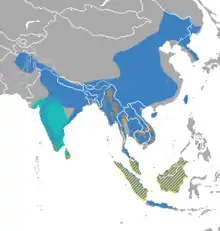 |
Size range: 35 cm (14 in) long, plus 20 cm (8 in) tail (rusty-spotted cat) to 85 cm (33 in) long, plus 30 cm (12 in) tail (fishing cat)[170]
Habitats: Inland wetlands, shrubland, grassland, forest, desert, and savanna[171] Diets: Primarily eats rodents, birds, and fish, as well as amphibians and lizards[171] |
| Puma
|
Jardine, 1834
One species
|
South America and Western North America |
Size range: 100–150 cm (39–59 in) long, 60–90 cm (24–35 in) tail[172]
Habitats: Forest, desert, grassland, savanna, and shrubland[173] Diets: Primarily eats deer, as well as smaller mammals such as feral pigs, raccoons and armadillos[173] |
| Name | Authority and species | Range | Size and ecology |
|---|---|---|---|
| Neofelis
|
Gray, 1867
Two species
|
Southeast Asia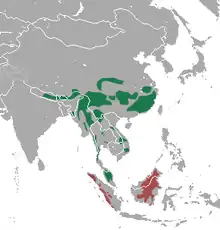 |
Size range: 69–108 cm (27–43 in) long, plus 61–91 cm (24–36 in) tail[174]
Habitats: Forest and shrubland[175] Diets: Primarily eats medium-sized and small mammals on the ground and in trees, as well as birds[175] |
| Panthera
|
Oken, 1816
Five species
|
South America, Central America, central Africa, central and southeast Asia | Size range: 90 cm (35 in) long, plus 80 cm (31 in) tail (snow leopard) to 250 cm (98 in) long, plus 100 cm (39 in) tail (lion)[176]
Habitats: Forest, shrubland, inland wetlands, savanna, grassland, rocky areas, and desert[177] Diets: Primarily eats ungulates, caprids, and other small to large mammals, as well as birds, insects, and reptiles[177] |
Herpestidae
Members of the Herpestidae family are herpestids, or colloquially mongooses. Herpestidae comprises two extant subfamilies, Herpestinae, comprising the species that are native to southern Europe, Africa and Asia, and Mungotinae, comprising the species native to Africa. There are 34 extant species in Herpestidae, divided into 14 genera.
| Name | Authority and species | Range | Size and ecology |
|---|---|---|---|
| Atilax
|
F. Cuvier, 1826
One species
|
Sub-Saharan Africa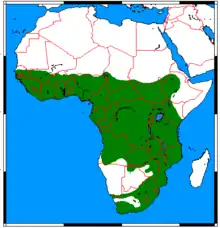 |
Size range: 46–64 cm (18–25 in) long, plus 31–41 cm (12–16 in) tail[178]
Habitats: Forest, grassland, inland wetlands, neritic marine, and coastal marine[179] Diets: Primarily eats crustaceans as well as other aquatic prey and rodents[179] |
| Bdeogale
|
Peters, 1850
Three species
|
Central Africa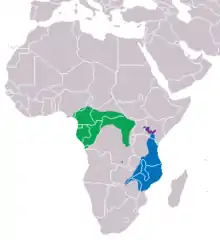 |
Size range: 36 cm (14 in) long, plus 22 cm (9 in) tail (bushy-tailed mongoose) to 65 cm (26 in) long, plus 40 cm (16 in) tail (black-footed mongoose)[178]
Habitats: Forest, savanna, and shrubland[180] Diets: Omnivorous, especially mammals and insects[180] |
| Cynictis
|
Ogilby, 1833
One species
|
Southern Africa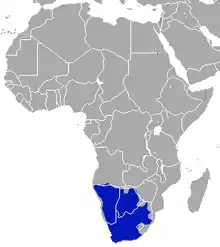 |
Size range: 26–46 cm (10–18 in) long, plus 16–30 cm (6–12 in) tail[178]
Habitats: Savanna, shrubland, and grassland[181] Diets: Primarily eats insects, as well as rodents, birds, other vertebrates, and arachnids[181] |
| Galerella (slender mongoose)
|
Gray, 1865
Five species
|
Sub-Saharan Africa |
Size range: 25 cm (10 in) long, plus 22 cm (9 in) tail (Somalian slender mongoose) to 43 cm (17 in) long, plus 34 cm (13 in) tail (Cape gray mongoose)[182]
Habitats: Shrubland, forest, rocky areas, inland wetlands, savanna, and desert[183] Diets: Primarily eats small mammals and insects, as well as birds, lizards, and snakes[183] |
| Herpestes
|
Illiger, 1811
Ten species
|
Africa, Mediterranean, and southern Asia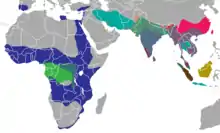 |
Size range: 25 cm (10 in) long, plus 24 cm (9 in) tail (Javan mongoose) to 61 cm (24 in) long, plus 43 cm (17 in) tail (Long-nosed mongoose)[184]
Habitats: Forest, savanna, shrubland, grassland, and inland wetlands[185] Diets: Generally omnivorous; some primarily eat rodents, birds, and reptiles[185] |
| Ichneumia
|
Geoffroy, 1837
One species
|
Sub-Saharan Africa, southern Arabic peninsula |
Size range: 51–104 cm (20–41 in) long, plus 34–47 cm (13–19 in) tail[178]
Habitats: Forest, savanna, shrubland, grassland, and inland wetlands[186] Diets: Primarily eats insects[186] |
| Paracynictis
|
Pocock, 1916
One species
|
Southern Africa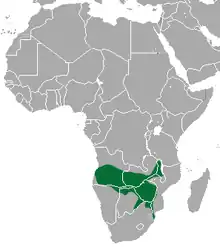 |
Size range: 63–90 cm (25–35 in) long, plus 28–43 cm (11–17 in) tail[187]
Habitats: Savanna and grassland[188] Diets: Primarily eats invertebrates, as well as small rodents, amphibians, reptiles, and birds[187][188] |
| Rhynchogale
|
Thomas, 1894
One species
|
Southeastern Africa |
Size range: 36–57 cm (14–22 in) long, plus 30–42 cm (12–17 in) tail[178]
Habitats: Forest, savanna, and shrubland[189] Diets: Primarily eats termites, as well as other invertebrates[178][189] |
| Name | Authority and species | Range | Size and ecology |
|---|---|---|---|
| Crossarchus (kusimanse)
|
F. Cuvier, 1825
Four species
|
Central Africa |
Size range: 21 cm (8 in) long, plus 15 cm (6 in) tail (Flat-headed kusimanse) to 44 cm (17 in) long, plus 32 cm (13 in) tail (Alexander's kusimanse)[190]
Habitats: Forest, savanna, and inland wetlands[191] Diets: Primarily eats insects, small vertebrates, eggs, and fruit[191] |
| Dologale
|
Thomas, 1926
One species
|
Central Africa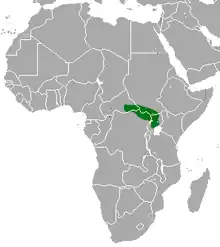 |
Size range: 24–30 cm (9–12 in) long, plus 16–22 cm (6–9 in) tail[178]
Habitats: Forest, savanna, and grassland[192] |
| Helogale (dwarf mongoose)
|
Gray, 1862
Two species
|
Central and east Africa |
Size range: 18 cm (7 in) long, plus 14 cm (6 in) tail (Common dwarf mongoose) to 26 cm (10 in) long, plus 20 cm (8 in) tail (Ethiopian dwarf mongoose)[193]
Habitats: Savanna, shrubland, and grassland[194] Diets: Primarily eats invertebrates, as well as small vertebrates[194] |
| Liberiictis | Hayman, 1958
One species
|
Western Africa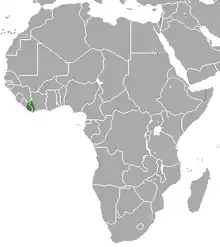 |
Size range: 42–55 cm (17–22 in) long, plus 18–21 cm (7–8 in) tail[178]
Habitats: Forest[195] Diets: Primarily eats earthworms, as well as small vertebrates, insect larvae, and fruit[195] |
| Mungos
|
Geoffroy, 1795
Two species
|
Sub-Saharan Africa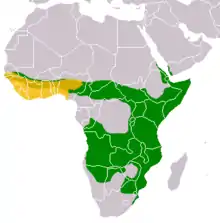 |
Size range: 30 cm (12 in) long, plus 19 cm (7 in) tail (Banded mongoose) to 36 cm (14 in) long, plus 22 cm (9 in) tail (Gambian mongoose)[178]
Habitats: Forest, savanna, shrubland, and grassland[196] Diets: Primarily eats insects, as well as other invertebrates, reptiles, amphibians, bird eggs, young birds, small mammals, and fruit[196] |
| Suricata
|
Desmarest, 1804
One species
|
Southern Africa |
Size range: 23–36 cm (9–14 in) long, plus 18–24 cm (7–9 in) tail[178]
Habitats: Savanna, shrubland, grassland, and desert[197] Diets: Primarily eats invertebrates[197] |
Hyaenidae
Members of the Hyaenidae family are hyaenids, or colloquially hyenas. Hyaenidae comprises four extant species, divided into three genera.
| Name | Authority and species | Range | Size and ecology |
|---|---|---|---|
| Crocuta
|
Kaup, 1828
One species
|
Sub-Saharan Africa |
Size range: 95–150 cm (37–59 in) long, plus 30–36 cm (12–14 in) tail[198]
Habitats: Forest, savanna, and grassland[199] Diets: Primarily eats medium to large mammals, as well as carrion[199] |
| Hyaena
|
Brisson, 1762
Two species
|
Africa and southern and western Asia |
Size range: 100 cm (39 in) long, plus 30 cm (12 in) tail (striped hyena) to 125 cm (49 in) long, plus 30 cm (12 in) tail (brown hyena)[200]
Habitats: Forest, savanna, shrubland, grassland, inland wetlands, rocky areas, desert, intertidal marine, coastal marine[201] Diets: Primarily eats carrion, as well as live vertebrates, insects, and fruit[201] |
| Proteles
|
Geoffroy, 1824
One species
|
Southern and eastern Africa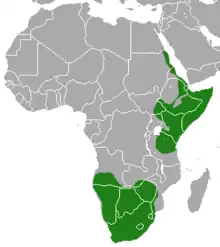 |
Size range: 55–85 cm (22–33 in) long, plus 20–30 cm (8–12 in) tail[202]
Habitats: Savanna, shrubland, and grassland[203] Diets: Primarily eats harvester termites[203] |
Nandiniidae
The Nandiniidae family is composed of a single extant species, the African palm civet.
| Name | Authority and species | Range | Size and ecology |
|---|---|---|---|
| Nandinia
|
Gray, 1843
One species
|
Central Africa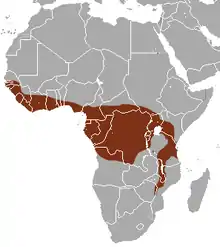 |
Size range: 37–63 cm (15–25 in) long, plus 34–77 cm (13–30 in) tail[204]
Habitats: Forest, savanna, and shrubland[205] Diets: Primarily eats fruit, as well as vertebrates and insects[205] |
Prionodontinae
The Prionodontinae family is composed of a two extant species in a single genus.
| Name | Authority and species | Range | Size and ecology |
|---|---|---|---|
| Prionodon (Asiatic linsang)
|
Horsfield, 1822
Two species
|
Southeast Asia | Size range:
Habitats: Forest, shrubland, and grassland[206] Diets: Primarily eats small vertebrates[206] |
Viverridae
Members of the Viverridae family are viverrids, and the family is composed mainly of the civets and genets. Viverridae comprises four extant subfamilies, the 3 civet subfamilies Viverrinae, Hemigalinae, and Paradoxurinae, and the genet subfamily Genettinae. There are 33 extant species in Herpestidae, divided into 14 genera.
| Name | Authority and species | Range | Size and ecology |
|---|---|---|---|
| Genetta (genet)
|
Cuvier, 1816
Fourteen species
|
Africa | Size range: 40 cm (16 in) long, plus 38 cm (15 in) tail (Abyssinian genet) to 68 cm (27 in) long, plus 47 cm (19 in) tail (king genet)[207]
Habitats: Forest, savanna, shrubland, grassland, inland wetlands, and rocky areas[208] Diets: Primarily eats small mammals, birds, insects, fruit, and seeds, as well as reptiles and amphibians[208] |
| Poiana (African linsang)
|
Gray, 1865
Two species
|
Central and western Africa | Size range: 30 cm (12 in) long, plus 35 cm (14 in) tail (West African oyan) to 38 cm (15 in) long, plus 40 cm (16 in) tail (Central African oyan)[209]
Habitats: Forest[210] Diets: Believed to eat small vertebrates and invertebrates[210] |
| Name | Authority and species | Range | Size and ecology |
|---|---|---|---|
| Chrotogale
|
Thomas, 1912
One species
|
Southeast Asia around Vietnam |
Size range: 51–63 cm (20–25 in) long, plus 38–48 cm (15–19 in) tail[211]
Habitats: Forest and shrubland[212] Diets: Believed to primarily eat earthworms and other invertebrates[212] |
| Cynogale
|
Gray, 1837
One species
|
Southeast Asia |
Size range: 57–68 cm (22–27 in) long, plus 12–21 cm (5–8 in) tail[211]
Habitats: Forest and inland wetlands[213] Diets: Primarily eats fish, crabs, molluscs, small mammals, and birds[213] |
| Diplogale
|
Thomas, 1912
One species
|
Borneo in Southeast Asia |
Size range: 47–54 cm (19–21 in) long, plus 29–34 cm (11–13 in) tail[214]
Habitats: Forest[215] Diets: Believed to primarily eat small fish, shrimp, crabs, and frogs as well as insects[215] |
| Hemigalus
|
Jourdan, 1837
One species
|
Southeast Asia |
Size range: 45–56 cm (18–22 in) long, plus 25–36 cm (10–14 in) tail[211]
Habitats: Forest[216] Diets: Primarily eats insects[216] |
| Name | Authority and species | Range | Size and ecology |
|---|---|---|---|
| Arctictis
|
Temminck, 1824
One species
|
Southeast Asia |
Size range: 61–96 cm (24–38 in) long, plus 56–89 cm (22–35 in) tail[217]
Habitats: Forest[218] Diets: Primarily eats fruit[218] |
| Arctogalidia
|
Merriam, 1897
One species
|
Southeast Asia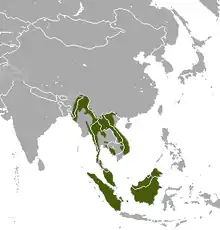 |
Size range: 44–60 cm (17–24 in) long, plus 48–66 cm (19–26 in) tail[219]
Habitats: Forest[220] Diets: Omnivorous; primarily eats fruit[220] |
| Macrogalidia
|
Schwarz, 1910
One species
|
Sulawesi island in Southeast Asia |
Size range: 65–72 cm (26–28 in) long, plus 44–54 cm (17–21 in) tail[221]
Habitats: Forest, shrubland, and grassland[222] Diets: Primarily eats rodents and palm fruit, as well as other small mammals, birds, fruit, and grass[222] |
| Paguma
|
Gray, 1831
One species
|
East and southeast Asia |
Size range: 50–76 cm (20–30 in) long, plus 50–64 cm (20–25 in) tail[223]
Habitats: Forest and shrubland[224] Diets: Omnivorous; primarily eats fruit[224] |
| Paradoxurus
|
F. Cuvier, 1821
Three species
|
South and southeast Asia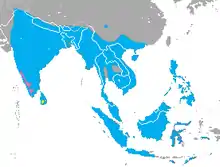 |
Size range: 43 cm (17 in) long, plus 38 cm (15 in) tail (brown palm civet) to 58 cm (23 in) long, plus 53 cm (21 in) tail (golden palm civet)[225]
Habitats: Forest, shrubland, and grassland[226] Diets: Omnivorous; primarily eats fruit and rodents[226] |
| Name | Authority and species | Range | Size and ecology |
|---|---|---|---|
| Civettictis
|
Pocock, 1915
One species
|
Central and south Africa |
Size range: 60–92 cm (24–36 in) long, plus 43–61 cm (17–24 in) tail[227]
Habitats: Forest, savanna, shrubland, and inland wetlands[228] Diets: Omnivorous; primarily eats fruit[228] |
| Viverra
|
Linnaeus, 1758
Four species
|
Southeast Asia and southwest India | Size range: 58 cm (23 in) long, plus 30 cm (12 in) tail (Malayan civet) to 95 cm (37 in) long, plus 59 cm (23 in) tail (Large Indian civet)[229]
Habitats: Forest, shrubland, and inland wetlands[230] Diets: Omnivorous[230] |
| Viverricula
|
Hodgson, 1838
One species
|
South and southeast Asia |
Size range: 45–63 cm (18–25 in) long, plus 30–43 cm (12–17 in) tail[231]
Habitats: Forest, savanna, shrubland, grassland, and inland wetlands[232] Diets: Primarily eats rodents, birds, snakes, fruit, roots, carrion, and insects[232] |
See also
References
- Roberts, M. S.; Gittleman, J. L. (1984). "Ailurus fulgens" (PDF). Mammalian Species (222): 1–8. doi:10.2307/3503840. JSTOR 3503840.
- Glatston, A.; Wei, F.; Zaw, T.; Sherpa, A. (2015). "Ailurus fulgens". IUCN Red List of Threatened Species. 2015: e.T714A45195924. doi:10.2305/IUCN.UK.2015-4.RLTS.T714A45195924.en.
- "Small-eared zorro (Atelocynus microtis)". ARKive. Wildscreen. Archived from the original on February 6, 2019. Retrieved May 28, 2019.
- Leite-Pitman, M. R. P.; Williams, R. S. R. (2011). "Atelocynus microtis". IUCN Red List of Threatened Species. 2011: e.T6924A12814890. doi:10.2305/IUCN.UK.2011-2.RLTS.T6924A12814890.en.
- Pitman, Williams, pp. 26–31
- Canis sizes:
- African golden wolf: Viranta, S.; Atickem, A.; Werdelin, L.; et al. (December 2017). "Rediscovering a forgotten canid species". BMC Zoology. 2 (6). doi:10.1186/s40850-017-0015-0. Archived from the original on July 20, 2018. Retrieved August 28, 2019.
- Coyote: Bekoff, M. (1977). "Canis latrans". Mammalian Species. 79 (79): 1–9. doi:10.2307/3503817. ISSN 1545-1410. JSTOR 3503817. OCLC 46381503.
- Ethiopian wolf: "Ethiopian wolf (Canis simensis)". ARKive. Wildscreen. Archived from the original on April 21, 2016. Retrieved August 21, 2019.
- Golden jackal: "Golden jackal (Canis aureus)". ARKive. Wildscreen. Archived from the original on April 23, 2016. Retrieved August 21, 2019.
- Wolf: Heptner, Naumov, pp. 164–270
- Canis habitats and diets:
- African golden wolf: Hoffmann, M.; Atickem, A. (2019). "Canis lupaster". IUCN Red List of Threatened Species. 2019: e.T118264888A118265889. doi:10.2305/IUCN.UK.2019-1.RLTS.T118264888A118265889.en.
Eddine, A.; Mostefai, N.; De Smet, K.; Klees, D.; Ansorge, H.; Karssene, Y.; Nowak, C.; Leer, P. (November 1, 2017). "Diet composition of a Newly Recognized Canid Species, the African Golden Wolf (Canis anthus), in Northern Algeria". Annales Zoologici Fennici. 54 (5–6): 347–356. doi:10.5735/086.054.0506. S2CID 90155276. - Coyote: Kays, R. (2018). "Canis latrans". IUCN Red List of Threatened Species. 2018: e.T3745A103893556. doi:10.2305/IUCN.UK.2018-2.RLTS.T3745A103893556.en.
- Ethiopian wolf: Marino, J.; Sillero-Zubiri, C. (2011). "Canis simensis". IUCN Red List of Threatened Species. 2011: e.T3748A10051312. doi:10.2305/IUCN.UK.2011-1.RLTS.T3748A10051312.en.
Sillero-Zubiri, C.; Gottelli, D. (December 2, 1994). "Canis simensis" (PDF). Mammalian Species (385): 1–6. doi:10.2307/3504136. JSTOR 3504136. Archived from the original (PDF) on September 24, 2015. Retrieved August 21, 2019. - Golden jackal: Hoffmann, M.; Arnold, J.; Duckworth, J. W.; Jhala, Y.; Kamler, J. F.; Krofel, M. (2018). "Canis aureus". IUCN Red List of Threatened Species. 2018: e.T118264161A46194820. doi:10.2305/IUCN.UK.2018-2.RLTS.T118264161A46194820.en.
- Wolf: Boitani, L.; Phillips, M.; Jhala, Y. (2018). "Canis lupus". IUCN Red List of Threatened Species. 2018: e.T3746A119623865. doi:10.2305/IUCN.UK.2018-2.RLTS.T3746A119623865.en.
"Grey wolf (Canis lupus)". ARKive. Wildscreen. Archived from the original on May 1, 2016. Retrieved August 21, 2019.
- African golden wolf: Hoffmann, M.; Atickem, A. (2019). "Canis lupaster". IUCN Red List of Threatened Species. 2019: e.T118264888A118265889. doi:10.2305/IUCN.UK.2019-1.RLTS.T118264888A118265889.en.
- Berta, A. (November 23, 1982). "Cerdocyon thous". Mammalian Species (186): 1–4. doi:10.2307/3503974. JSTOR 3503974.
- Lucherini, M. (2015). "Cerdocyon thous". IUCN Red List of Threatened Species. 2015: e.T4248A81266293. doi:10.2305/IUCN.UK.2015-4.RLTS.T4248A81266293.en.
- "Maned wolf (Chrysocyon brachyurus)". ARKive. Wildscreen. Archived from the original on September 13, 2009. Retrieved May 23, 2019.
- Dietz, J. M. (1984). "Ecology and social organization of the maned wolf (Chrysocyon brachyurus)". Smithsonian Contributions to Zoology (392): 1–51. doi:10.5479/si.00810282.392.
- Paula, R. C.; DeMatteo, K. (2016). "Chrysocyon brachyurus". IUCN Red List of Threatened Species. 2015: e.T4819A82316878. doi:10.2305/IUCN.UK.2015-4.RLTS.T4819A82316878.en.
- "Dhole (Cuon alpinus)". ARKive. Wildscreen. Archived from the original on September 7, 2017. Retrieved August 21, 2019.
- Kamler, J. F.; Songsasen, N.; Jenks, K.; Srivathsa, A.; Sheng, L.; Kunkel, K. (2015). "Cuon alpinus". IUCN Red List of Threatened Species. 2015: e.T5953A72477893. doi:10.2305/IUCN.UK.2015-4.RLTS.T5953A72477893.en.
- Dusicyon habitats and diets:
- Falkland Islands wolf: Sillero-Zubiri, C. (2015). "Dusicyon australis". IUCN Red List of Threatened Species. 2015: e.T6923A82310440. doi:10.2305/IUCN.UK.2015-4.RLTS.T6923A82310440.en.
- South American fox: Sillero-Zubiri, C. (2015). "Dusicyon avus". IUCN Red List of Threatened Species. 2015: e.T82337482A82337485. doi:10.2305/IUCN.UK.2015-4.RLTS.T82337482A82337485.en.
- Lupulella sizes:
- Side-striped jackal: Burnie, Wilson (2011), ch. Side-striped jackal
- Black-backed jackal: de Waal, H. O. (September 2017). "Demography and morphometry of black-backed jackals Canis mesomelasin South Africa and Namibia" (PDF). African Large Predator Research Unit. Retrieved August 21, 2019.
- Lupulella habitats and diets:
- Side-striped jackal: Hoffmann, M. (2014). "Canis adustus". IUCN Red List of Threatened Species. 2014: e.T3753A46254734. doi:10.2305/IUCN.UK.2014-1.RLTS.T3753A46254734.en.
Camacho, Page-Nicholson, Child, Do Linh San, ch. 7. A conservation assessment of Canis adustus - Black-backed jackal: Hoffmann, M. (2014). "Canis mesomelas". IUCN Red List of Threatened Species. 2014: e.T3755A46122476. doi:10.2305/IUCN.UK.2014-1.RLTS.T3755A46122476.en.
Minnie, Avenant, Drouilly, Samuels, pp. 178–204
- Side-striped jackal: Hoffmann, M. (2014). "Canis adustus". IUCN Red List of Threatened Species. 2014: e.T3753A46254734. doi:10.2305/IUCN.UK.2014-1.RLTS.T3753A46254734.en.
- Lycalopex sizes:
- Culpeo: Burnie, Wilson (2011), ch. Culpeo
- Darwin's fox, Hoary fox, Pampas fox, Sechuran fox, South American gray fox: Hunter, pp. 110–126
- Lycalopex habitats and diets:
- Culpeo: Lucherini, M. (2016). "Lycalopex culpaeus". IUCN Red List of Threatened Species. 2016: e.T6929A85324366. doi:10.2305/IUCN.UK.2016-1.RLTS.T6929A85324366.en.
- Darwin's fox: Silva-Rodríguez, E.; Farias, A.; Moreira-Arce, D.; Cabello, J.; Hidalgo-Hermoso, E.; Lucherini, M.; Jiménez, J. (2016). "Lycalopex fulvipes". IUCN Red List of Threatened Species. 2016: e.T41586A85370871. doi:10.2305/IUCN.UK.2016-1.RLTS.T41586A85370871.en.
- Hoary fox: Dalponte, J.; Courtenay, O. (2008). "Lycalopex vetulus". IUCN Red List of Threatened Species. 2008: e.T6926A12815527. doi:10.2305/IUCN.UK.2008.RLTS.T6926A12815527.en.
- Pampas fox: Lucherini, M. (2016). "Lycalopex gymnocercus". IUCN Red List of Threatened Species. 2016: e.T6928A85371194. doi:10.2305/IUCN.UK.2016-1.RLTS.T6928A85371194.en.
- Sechuran fox: Cossios, D. (2017). "Lycalopex sechurae". IUCN Red List of Threatened Species. 2017: e.T6925A86074993. doi:10.2305/IUCN.UK.2017-2.RLTS.T6925A86074993.en.
- South American gray fox: Lucherini, M. (2017). "Lycalopex griseus". IUCN Red List of Threatened Species. 2016: e.T6927A86440397. doi:10.2305/IUCN.UK.2016-1.RLTS.T6927A86440397.en.
- Hunter, pp. 110–126
- Woodroffe, R.; Sillero-Zubiri, C. (2012). "Lycaon pictus". IUCN Red List of Threatened Species. 2012: e.T12436A16711116. doi:10.2305/IUCN.UK.2012.RLTS.T12436A16711116.en.
- Kauhala, K.; Saeki, M. (2016). "Nyctereutes procyonoides". IUCN Red List of Threatened Species. 2016: e.T14925A85658776. doi:10.2305/IUCN.UK.2016-1.RLTS.T14925A85658776.en.
- Hoffmann, M. (2014). "Otocyon megalotis". IUCN Red List of Threatened Species. 2014: e.T15642A46123809. doi:10.2305/IUCN.UK.2014-1.RLTS.T15642A46123809.en.
- "Bush dog (Speothos venaticus)". ARKive. Wildscreen. Archived from the original on December 5, 2008. Retrieved May 23, 2019.
- DeMatteo, K.; Michalski, F.; Leite-Pitman, M. R. P. (2011). "Speothos venaticus". IUCN Red List of Threatened Species. 2011: e.T20468A9203243. doi:10.2305/IUCN.UK.2011-2.RLTS.T20468A9203243.en.
- Urocyon habitats and diets:
- Gray fox: Roemer, G.; Cypher, B.; List, R. (2016). "Urocyon cinereoargenteus". IUCN Red List of Threatened Species. 2016: e.T22780A46178068. doi:10.2305/IUCN.UK.2016-1.RLTS.T22780A46178068.en.
- Island fox: Coonan, T.; Ralls, K.; Hudgens, B.; Cypher, B.; Boser, C. (2013). "Urocyon littoralis". IUCN Red List of Threatened Species. 2013: e.T22781A13985603. doi:10.2305/IUCN.UK.2013-2.RLTS.T22781A13985603.en.
- Vulpes sizes:
- Red fox: "Red fox (Vulpes vulpes)". ARKive. Wildscreen. Archived from the original on June 22, 2017. Retrieved August 22, 2019.
- All others: Hunter, pp. 110–126
- Vulpes habitats and diets:
- Arctic fox: Angerbjörn, A.; Tannerfeldt, M. (2014). "Vulpes lagopus". IUCN Red List of Threatened Species. 2014: e.T899A57549321. doi:10.2305/IUCN.UK.2014-2.RLTS.T899A57549321.en.
- Bengal fox: Jhala, Y. (2016). "Vulpes bengalensis". IUCN Red List of Threatened Species. 2016: e.T23049A81069636. doi:10.2305/IUCN.UK.2016-1.RLTS.T23049A81069636.en.
- Blanfords fox: Hoffmann, M.; Sillero-Zubiri, C. (2015). "Vulpes cana". IUCN Red List of Threatened Species. 2015: e.T23050A48075169. doi:10.2305/IUCN.UK.2015-4.RLTS.T23050A48075169.en.
- Cape fox: Hoffmann, M. (2014). "Vulpes chama". IUCN Red List of Threatened Species. 2014: e.T23060A46126992. doi:10.2305/IUCN.UK.2014-1.RLTS.T23060A46126992.en.
- Corsac fox: Murdoch, J. D. (2014). "Vulpes corsac". IUCN Red List of Threatened Species. 2014: e.T23051A59049446. doi:10.2305/IUCN.UK.2014-2.RLTS.T23051A59049446.en.
- Fennec fox: Wacher, T.; Bauman, K.; Cuzin, F. (2015). "Vulpes zerda". IUCN Red List of Threatened Species. 2015: e.T41588A46173447. doi:10.2305/IUCN.UK.2015-4.RLTS.T41588A46173447.en.
- Kit fox: Cypher, B.; List, R. (2014). "Vulpes macrotis". IUCN Red List of Threatened Species. 2014: e.T41587A62259374. doi:10.2305/IUCN.UK.2014-3.RLTS.T41587A62259374.en.
- Pale fox: Sillero-Zubiri, C.; Wacher, T. (2012). "Vulpes pallida". IUCN Red List of Threatened Species. 2012: e.T23052A16813736. doi:10.2305/IUCN.UK.2012.RLTS.T23052A16813736.en.
- Rüppell's fox: Mallon, D.; Murdoch, J. D.; Wacher, T. (2015). "Vulpes rueppellii". IUCN Red List of Threatened Species. 2015: e.T23053A46197483. doi:10.2305/IUCN.UK.2015-4.RLTS.T23053A46197483.en.
- Red fox: Hoffmann, M.; Sillero-Zubiri, C. (2016). "Vulpes vulpes". IUCN Red List of Threatened Species. 2016: e.T23062A46190249. doi:10.2305/IUCN.UK.2016-1.RLTS.T23062A46190249.en.
- Swift fox: Moehrenschlager, A.; Sovada, M. (2016). "Vulpes velox". IUCN Red List of Threatened Species. 2016: e.T23059A57629306. doi:10.2305/IUCN.UK.2016-3.RLTS.T23059A57629306.en.
- Tibetan sand fox: Harris, R. (2014). "Vulpes ferrilata". IUCN Red List of Threatened Species. 2014: e.T23061A46179412. doi:10.2305/IUCN.UK.2014-3.RLTS.T23061A46179412.en.
- Conepatus sizes:
- Humboldt's hog-nosed skunk: Shaw, Weylan (2002). "Conepatus humboldtii". Animal Diversity Web. University of Michigan. Retrieved April 14, 2020.
- American hog-nosed skunk, Molina's hog-nosed skunk, Striped hog-nosed skunk: Hunter, pp. 150–156
- Conepatus habitats and diets:
- Molina's hog-nosed skunk: Emmons, L.; Schiaffini, M.; Schipper, J. (2016). "Conepatus chinga". IUCN Red List of Threatened Species. 2016: e.T41630A45210528. doi:10.2305/IUCN.UK.2016-1.RLTS.T41630A45210528.en.
- Humbold'ts hog-nosed skunk: Emmons, L.; Helgen, K. (2016). "Conepatus humboldtii". IUCN Red List of Threatened Species. 2016: e.T41631A45210677. doi:10.2305/IUCN.UK.2016-1.RLTS.T41631A45210677.en.
- American hog-nosed skunk: Helgen, K. (2016). "Conepatus leuconotus". IUCN Red List of Threatened Species. 2016: e.T41632A45210809. doi:10.2305/IUCN.UK.2016-1.RLTS.T41632A45210809.en.
- Striped hog-nosed skunk: Cuarón, A. D.; Helgen, K.; Reid, F. (2016). "Conepatus semistriatus". IUCN Red List of Threatened Species. 2016: e.T41633A45210987. doi:10.2305/IUCN.UK.2016-1.RLTS.T41633A45210987.en.
- Mephitis sizes:
- Hooded skunk: Bairos-Novak, Kevin (2014). "Mephitis macroura". Animal Diversity Web. University of Michigan. Retrieved April 14, 2020.
- Striped skunk: Kiiskila, Jeffrey (2014). "Mephitis mephitis". Animal Diversity Web. University of Michigan. Retrieved April 14, 2020.
- Mephitis habitats and diets:
- Hooded skunk: Cuarón, A. D.; González-Maya, J. F.; Helgen, K.; Reid, F.; Schipper, J.; Dragoo, J. W. (2016). "Mephitis macroura". IUCN Red List of Threatened Species. 2016: e.T41634A45211135. doi:10.2305/IUCN.UK.2016-1.RLTS.T41634A45211135.en.
- Striped skunk: Helgen, K.; Reid, F. (2016). "Mephitis mephitis". IUCN Red List of Threatened Species. 2016: e.T41635A45211301. doi:10.2305/IUCN.UK.2016-1.RLTS.T41635A45211301.en.
- Mydaus sizes:
- Sunda stink badger: Krauskopf, Rachel (2002). "Mydaus javanensis". Animal Diversity Web. University of Michigan. Retrieved April 14, 2020.
- Palawan stink badger: Hunter, pp. 150–156
- Mydaus habitats and diets:
- Sunda stink badger: Wilting, A.; Duckworth, J. W.; Meijaard, E.; Ross, J.; Hearn, A.; Ario, A. (2015). "Mydaus javanensis". IUCN Red List of Threatened Species. 2015: e.T41628A45209955. doi:10.2305/IUCN.UK.2015-4.RLTS.T41628A45209955.en.
- Palawan stink badger: Widmann, P. (2015). "Mydaus marchei". IUCN Red List of Threatened Species. 2015: e.T14055A45201420. doi:10.2305/IUCN.UK.2015-4.RLTS.T14055A45201420.en.
- Spilogale sizes:
- Southern spotted skunk, Western spotted skunk: Hunter, pp. 150–156
- Eastern spotted skunk: Pennington, Stefanie (2002). "Spilogale putorius". Animal Diversity Web. University of Michigan. Retrieved April 14, 2020.
- Pygmy spotted skunk: Gay, Bradley David (1999). "Spilogale pygmaea". Animal Diversity Web. University of Michigan. Retrieved April 14, 2020.
- Spilogale habitats and diets:
- Southern spotted skunk: Helgen, K.; Reid, F.; Timm, R. (2016). "Spilogale angustifrons". IUCN Red List of Threatened Species. 2016: e.T136636A45221538. doi:10.2305/IUCN.UK.2016-1.RLTS.T136636A45221538.en.
- Western spotted skunk: Cuarón, A. D.; Helgen, K.; Reid, F. (2016). "Spilogale gracilis". IUCN Red List of Threatened Species. 2016: e.T136797A45221721. doi:10.2305/IUCN.UK.2016-1.RLTS.T136797A45221721.en.
- Eastern spotted skunk: Gompper, M.; Jachowski, D. (2016). "Spilogale putorius". IUCN Red List of Threatened Species. 2016: e.T41636A45211474. doi:10.2305/IUCN.UK.2016-1.RLTS.T41636A45211474.en.
- Pygmy spotted skunk: Helgen, K.; Cuarón, A. D.; Schipper, J.; González-Maya, J. F. (2016). "Spilogale pygmaea". IUCN Red List of Threatened Species. 2016: e.T41637A45211592. doi:10.2305/IUCN.UK.2016-1.RLTS.T41637A45211592.en.
- Schreffler, Christina (2003). "Eira barbara". Animal Diversity Web. University of Michigan. Retrieved November 13, 2019.
- Cuarón, A. D.; Reid, F.; Helgen, K.; González-Maya, J. F. (2016). "Eira barbara". IUCN Red List of Threatened Species. 2016: e.T41644A45212151. doi:10.2305/IUCN.UK.2016-1.RLTS.T41644A45212151.en.
- Streubel, Donald (2000). "Wolverine". Digital Atlas of Idaho. Idaho State University. Archived from the original on August 22, 2016. Retrieved October 2, 2019.
- Abramov, A. V. (2016). "Gulo gulo". IUCN Red List of Threatened Species. 2016: e.T9561A45198537. doi:10.2305/IUCN.UK.2016-1.RLTS.T9561A45198537.en.
- Martes sizes:
- American marten: Streubel, Donald (2000). "American Marten". Digital Atlas of Idaho. Idaho State University. Archived from the original on August 22, 2016. Retrieved October 2, 2019.
- Beech marten: Carter, Kimberlee (2004). "Martes foina". Animal Diversity Web. University of Michigan. Retrieved November 13, 2019.
- European pine marten: Schwanz, Lisa (2000). "Martes martes". Animal Diversity Web. University of Michigan. Retrieved November 13, 2019.
- Japanese marten: Barthen, Bill (2003). "Martes melampus". Animal Diversity Web. University of Michigan. Retrieved November 13, 2019.
- Nilgiri marten: Webb, Amanda (2013). "Martes gwatkinsii". Animal Diversity Web. University of Michigan. Retrieved November 13, 2019.
- Sable: Bates, Jeremy (2002). "Martes zibellina". Animal Diversity Web. University of Michigan. Retrieved November 13, 2019.
- Yellow-throated marten: Shak, Marcus (2012). "Martes flavigula". Animal Diversity Web. University of Michigan. Retrieved November 13, 2019.
- Martes habitats and diets:
- American marten: Helgen, K.; Reid, F. (2016). "Martes americana". IUCN Red List of Threatened Species. 2016: e.T41648A45212861. doi:10.2305/IUCN.UK.2016-1.RLTS.T41648A45212861.en.
- Beech marten: Abramov, A. V.; Kranz, A.; Herrero, J.; Choudhury, A.; Maran, T. (2016). "Martes foina". IUCN Red List of Threatened Species. 2016: e.T29672A45202514. doi:10.2305/IUCN.UK.2016-1.RLTS.T29672A45202514.en.
- European pine marten: Herrero, J.; Kranz, A.; Skumatov, D.; Abramov, A. V.; Maran, T.; Monakhov, V. G. (2016). "Martes martes". IUCN Red List of Threatened Species. 2016: e.T12848A45199169. doi:10.2305/IUCN.UK.2016-1.RLTS.T12848A45199169.en.
- Japanese marten: Abramov, A. V.; Kaneko, Y.; Masuda, R. (2015). "Martes melampus". IUCN Red List of Threatened Species. 2015: e.T41650A45213228. doi:10.2305/IUCN.UK.2015-4.RLTS.T41650A45213228.en.
- Nilgiri marten: Mudappa, D.; Jathana, D.; Raman, T. R. S. (2015). "Martes gwatkinsii". IUCN Red List of Threatened Species. 2015: e.T12847A45199025. doi:10.2305/IUCN.UK.2015-4.RLTS.T12847A45199025.en.
- Sable: Monakhov, V. G. (2016). "Martes zibellina". IUCN Red List of Threatened Species. 2016: e.T41652A45213477. doi:10.2305/IUCN.UK.2016-1.RLTS.T41652A45213477.en.
- Yellow-throated marten: Chutipong, W.; Duckworth, J. W.; Timmins, R. J.; Choudhury, A.; Abramov, A. V.; Roberton, S.; Long, B.; Rahman, H.; Hearn, A.; Dinets, V.; Willcox, D. H. A. (2016). "Martes flavigula". IUCN Red List of Threatened Species. 2016: e.T41649A45212973. doi:10.2305/IUCN.UK.2016-1.RLTS.T41649A45212973.en.
- Rhines, Cynthia (2003). "Martes pennanti". Animal Diversity Web. University of Michigan. Retrieved October 15, 2019.
- Helgen, K.; Reid, F. (2016). "Martes pennanti (amended version of 2016 assessment)". IUCN Red List of Threatened Species. 2016: e.T41651A125236220. doi:10.2305/IUCN.UK.2016-2.RLTS.T41651A125236220.en.
- Melogale sizes:
- Bornean ferret-badger: Edmison, Nicole (2003). "Melogale everetti". Animal Diversity Web. University of Michigan. Retrieved November 13, 2019.
- Burmese ferret-badger: Clarke, Rosie (2003). "Melogale personata". Animal Diversity Web. University of Michigan. Retrieved November 13, 2019.
- Chinese ferret-badgerSize: Smith, Xie, et. al., p. 441
- Javan ferret-badger: Denryter, Kristin (2013). "Melogale orientalis". Animal Diversity Web. University of Michigan. Retrieved November 13, 2019.
- Melogale habitats and diets:
- Bornean ferret-badger: Wilting, A.; Duckworth, J. W.; Hearn, A.; Ross, J. (2015). "Melogale everetti". IUCN Red List of Threatened Species. 2015: e.T13110A45199541. doi:10.2305/IUCN.UK.2015-4.RLTS.T13110A45199541.en.
- Burmese ferret-badger: Duckworth, J. W.; Long, B.; Willcox, D. H. A.; Coudrat, C. N. Z.; Timmins, R. J.; Abramov, A. V.; Chan, B.; Chutipong, W. (2016). "Melogale personata". IUCN Red List of Threatened Species. 2016: e.T41627A45209826. doi:10.2305/IUCN.UK.2016-1.RLTS.T41627A45209826.en.
- Chinese ferret-badger: Duckworth, J. W.; Abramov, A. V.; Willcox, D. H. A.; Timmins, R. J.; Choudhury, A.; Roberton, S.; Long, B.; Lau, M. (2016). "Melogale moschata". IUCN Red List of Threatened Species. 2016: e.T41626A45209676. doi:10.2305/IUCN.UK.2016-1.RLTS.T41626A45209676.en.
- Javan ferret-badger: Duckworth, J. W.; Shepherd, C.; Rode-Margono, E. J.; Wilianto, E.; Spaan, D.; Abramov, A. V. (2016). "Melogale orientalis". IUCN Red List of Threatened Species. 2016: e.T41697A45218557. doi:10.2305/IUCN.UK.2016-1.RLTS.T41697A45218557.en.
- Vietnam ferret-badger: Helgen, K.; Long, B. (2016). "Melogale cucphuongensis". IUCN Red List of Threatened Species. 2016: e.T68369199A68369432. doi:10.2305/IUCN.UK.2016-1.RLTS.T68369199A68369432.en.
- Galictis sizes:
- Greater grison: Gregg, Mackenzie (2013). "Galictis grison". Animal Diversity Web. University of Michigan. Retrieved November 21, 2019.
- Lesser grison: Melrose, Robert (2004). "Galictis cuja". Animal Diversity Web. University of Michigan. Retrieved November 21, 2019.
- Galictis habitats and diets:
- Greater grison: Cuarón, A. D.; Reid, F.; González-Maya, J. F.; Helgen, K. (2016). "Galictis vittata". IUCN Red List of Threatened Species. 2016: e.T41640A45211961. doi:10.2305/IUCN.UK.2016-1.RLTS.T41640A45211961.en.
- Lesser grison: Helgen, K.; Schiaffini, M. (2016). "Galictis cuja". IUCN Red List of Threatened Species. 2016: e.T41639A45211832. doi:10.2305/IUCN.UK.2016-1.RLTS.T41639A45211832.en.
- Ictonyx sizes:
- Striped polecat: Aguilar, William (2003). "Ictonyx striatus". Animal Diversity Web. University of Michigan. Retrieved November 21, 2019.
- Saharan striped polecat: Hoath, pp. 82–84
- Ictonyx habitats and diets:
- Striped polecat: Stuart, C.; Stuart, M.; Do Linh San, E. (2015). "Ictonyx striatus". IUCN Red List of Threatened Species. 2015: e.T41646A45212491. doi:10.2305/IUCN.UK.2015-4.RLTS.T41646A45212491.en.
- Saharan striped polecat: Ahmim, M.; Do Linh San, E. (2015). "Ictonyx libycus". IUCN Red List of Threatened Species. 2015: e.T41645A45212347. doi:10.2305/IUCN.UK.2015-4.RLTS.T41645A45212347.en.
- Malek, Karen (2003). "Lyncodon patagonicus". Animal Diversity Web. University of Michigan. Retrieved November 21, 2019.
- Kelt, D.; Pardiñas, U.; Schiaffini, M.; González-Maya, J. F. (2016). "Lyncodon patagonicus". IUCN Red List of Threatened Species. 2016: e.T41647A45212747. doi:10.2305/IUCN.UK.2016-1.RLTS.T41647A45212747.en.
- Brilliant, Matt (2000). "Poecilogale albinucha". Animal Diversity Web. University of Michigan. Retrieved November 21, 2019.
- Stuart, C.; Stuart, M.; Do Linh San, E. (2015). "Poecilogale albinucha". IUCN Red List of Threatened Species. 2015: e.T41662A45215258. doi:10.2305/IUCN.UK.2015-4.RLTS.T41662A45215258.en.
- Petroelje, Tyler (2011). "Vormela peregusna". Animal Diversity Web. University of Michigan. Retrieved November 22, 2019.
- Abramov, A. V.; Kranz, A.; Maran, T. (2016). "Vormela peregusna". IUCN Red List of Threatened Species. 2016: e.T29680A45203971. doi:10.2305/IUCN.UK.2016-1.RLTS.T29680A45203971.en.
- Aonyx sizes:
- African clawless otter: "African Clawless Otter (Aonyx capensis)". IUCN Otter Specialist Group. Retrieved November 26, 2019.
- Asian small-clawed otter: "Asian Small-clawed Otter (Aonyx cinereus)". IUCN Otter Specialist Group. Retrieved November 26, 2019.
- Aonyx habitats and diets:
- African clawless otter: Jacques, H.; Reed-Smith, J.; Somers, M. J. (2015). "Aonyx capensis". IUCN Red List of Threatened Species. 2015: e.T1793A21938767. doi:10.2305/IUCN.UK.2015-2.RLTS.T1793A21938767.en.
- Asian small-clawed otter: Wright, L.; de Silva, P.; Chan, B.; Reza Lubis, I. (2015). "Aonyx cinereus". IUCN Red List of Threatened Species. 2015: e.T44166A21939068. doi:10.2305/IUCN.UK.2015-2.RLTS.T44166A21939068.en.
- "Sea Otter (Enhydra lutris)". IUCN Otter Specialist Group. Retrieved November 26, 2019.
- Doroff, A.; Burdin, A. (2015). "Enhydra lutris". IUCN Red List of Threatened Species. 2015: e.T7750A21939518. doi:10.2305/IUCN.UK.2015-2.RLTS.T7750A21939518.en.
- "Spotted-necked Otter (Hydrictis maculicollis)". IUCN Otter Specialist Group. Retrieved November 26, 2019.
- Reed-Smith, J.; Jacques, H.; Somers, M. J. (2015). "Hydrictis maculicollis". IUCN Red List of Threatened Species. 2015: e.T12420A21936042. doi:10.2305/IUCN.UK.2015-2.RLTS.T12420A21936042.en.
- Lontra sizes:
- North American river otter: "North American River Otter (Lontra canadensis)". IUCN Otter Specialist Group. Retrieved November 26, 2019.
- Southern river otter: "Southern River Otter (Lontra provocax)". IUCN Otter Specialist Group. Retrieved November 26, 2019.
- Neotropical otter: "Neotropical Otter (Lontra longicaudis)". IUCN Otter Specialist Group. Retrieved November 26, 2019.
- Marine otter: Jefferson, Webber, Pitman, pp. 539–541
- Lontra habitats and diets:
- North American river otter: Serfass, T.; Evans, S. S.; Polechla, P. (2015). "Lontra canadensis". IUCN Red List of Threatened Species. 2015: e.T12302A21936349. doi:10.2305/IUCN.UK.2015-2.RLTS.T12302A21936349.en.
- Southern river otter: Sepúlveda, M. A.; Valenzuela, A. E. J.; Pozzi, C.; Medina-Vogel, G.; Chehébar, C. (2015). "Lontra provocax". IUCN Red List of Threatened Species. 2015: e.T12305A21938042. doi:10.2305/IUCN.UK.2015-2.RLTS.T12305A21938042.en.
- Neotropical otter: Rheingantz, M. L.; Trinca, C. S. (2015). "Lontra longicaudis". IUCN Red List of Threatened Species. 2015: e.T12304A21937379. doi:10.2305/IUCN.UK.2015-2.RLTS.T12304A21937379.en.
- Marine otter: Valqui, J.; Rheingantz, M. L. (2015). "Lontra felina". IUCN Red List of Threatened Species. 2015: e.T12303A21937779. doi:10.2305/IUCN.UK.2015-2.RLTS.T12303A21937779.en.
- Lutra sizes:
- Eurasian otter: "Eurasian Otter (Lutra lutra)". IUCN Otter Specialist Group. Retrieved November 26, 2019.
- Hairy-nosed otter: "Hairy-nosed Otter (Lutra sumatrana)". IUCN Otter Specialist Group. Retrieved November 26, 2019.
- Lutra habitats and diets:
- Eurasian otter: Roos, A.; Loy, A.; de Silva, P.; Hajkova, P.; Zemanová, B. (2015). "Lutra lutra". IUCN Red List of Threatened Species. 2015: e.T12419A21935287. doi:10.2305/IUCN.UK.2015-2.RLTS.T12419A21935287.en.
- Hairy-nosed otter: Aadrean, A.; Kanchanasaka, B.; Heng, S.; Reza Lubis, I.; de Silva, P.; Olsson, A. (2015). "Lutra sumatrana". IUCN Red List of Threatened Species. 2015: e.T12421A21936999. doi:10.2305/IUCN.UK.2015-2.RLTS.T12421A21936999.en.
- "Smooth-coated Otter (Lutrogale perspicillata)". IUCN Otter Specialist Group. Retrieved November 26, 2019.
- de Silva, P.; Khan, W. A.; Kanchanasaka, B.; Reza Lubis, I.; Feeroz, M. M.; Al-Sheikhly, O. F. (2015). "Lutrogale perspicillata". IUCN Red List of Threatened Species. 2015: e.T12427A21934884. doi:10.2305/IUCN.UK.2015-2.RLTS.T12427A21934884.en.
- "Giant Otter (Pteronura brasiliensis)". IUCN Otter Specialist Group. Retrieved November 26, 2019.
- Groenendijk, J.; Duplaix, N.; Marmontel, M.; Van Damme, P.; Schenck, C. (2015). "Pteronura brasiliensis". IUCN Red List of Threatened Species. 2015: e.T18711A21938411. doi:10.2305/IUCN.UK.2015-2.RLTS.T18711A21938411.en.
- Toben, Jacob (2013). "Arctonyx collaris". Animal Diversity Web. University of Michigan. Retrieved November 26, 2019.
- Duckworth, J. W.; Timmins, R.; Chutipong, W.; Gray, T. N. E.; Long, B.; Helgen, K.; Rahman, H.; Choudhury, A.; Willcox, D. H. A. (2016). "Arctonyx collaris". IUCN Red List of Threatened Species. 2016: e.T70205537A45209459. doi:10.2305/IUCN.UK.2016-1.RLTS.T70205537A45209459.en.
- Meles sizes:
- Asian badger: Smith, Xie, p. 326
- European badger: Wang, Annie (2011). "Meles meles". Animal Diversity Web. University of Michigan. Retrieved November 27, 2019.
- Japanese badger: Riney, Julie (2011). "Meles anakuma". Animal Diversity Web. University of Michigan. Retrieved November 27, 2019.
- Meles habitats and diets:
- Asian badger: Abramov, A. V. (2016). "Meles leucurus". IUCN Red List of Threatened Species. 2016: e.T136385A45221149. doi:10.2305/IUCN.UK.2016-1.RLTS.T136385A45221149.en.
- European badger: Kranz, A.; Abramov, A. V.; Herrero, J.; Maran, T. (2016). "Meles meles". IUCN Red List of Threatened Species. 2016: e.T29673A45203002. doi:10.2305/IUCN.UK.2016-1.RLTS.T29673A45203002.en.
- Japanese badger: Kaneko, Y.; Masuda, R.; Abramov, A. V. (2016). "Meles anakuma". IUCN Red List of Threatened Species. 2016: e.T136242A45221049. doi:10.2305/IUCN.UK.2016-1.RLTS.T136242A45221049.en.
- "Honey Badger (Ratel)". San Diego Zoo Animals & Plants. San Diego Zoo. Retrieved November 27, 2019.
- Do Linh San, E.; Begg, C.; Begg, K.; Abramov, A. V. (2016). "Mellivora capensis". IUCN Red List of Threatened Species. 2016: e.T41629A45210107. doi:10.2305/IUCN.UK.2016-1.RLTS.T41629A45210107.en.
- Mustela sizes:
- Amazon weasel: Ramírez-Chaves, H. E.; Arango-Guerra, H. L.; Patterson, B. D. (December 18, 2014). "Mustela africana (Carnivora: Mustelidae)". Mammalian Species. 46 (917): 110–115. doi:10.1644/917.1.
- Back-striped weasel: Stewart, Reynaud (2013). "Mustela strigidorsa". Animal Diversity Web. University of Michigan. Retrieved December 12, 2019.
- Black-footed ferret: Hillman, Conrad N.; Clark, Tim W. (April 15, 1980). "Mustela nigripes". Mammalian Species. 1 (126): 1–3. doi:10.2307/3503892. JSTOR 3503892.
- Colombian weasel: Chaves, Héctor E. Ramírez; Patterson, Bruce D. (August 8, 2014). "Mustela felipei (Carnivora: Mustelidae)". Mammalian Species. 46 (906): 11–15. doi:10.1644/906.
- Egyptian weasel: "Mustela subpalmata". ARKive. Wildscreen. Archived from the original on December 23, 2014. Retrieved December 16, 2019.
- European mink: Heptner, Sludskii, pp. 1083–1084
- European polecat: Heptner, Sludskii, pp. 1114–1115
- Indonesian mountain weasel: Hunt, Amelia (2013). "Mustela lutreolina". Animal Diversity Web. University of Michigan. Retrieved December 16, 2019.
- Japanese weasel: Abramov, Alexei V. "On a taxonomic position of the weasel (Carnivora, Mustela) from the Cheju Island (South Korea)". Russian Journal of Theriology. 4 (2): 112.
- Least weasel: Heptner, Sludskii, pp. 970–972
- Long-tailed weasel: Newell, Toni Lynn (2002). "Mustela frenata". Animal Diversity Web. University of Michigan. Retrieved December 16, 2019.
- Malayan weasel: Kohlmann, Jodie (2014). "Mustela nudipes". Animal Diversity Web. University of Michigan. Retrieved December 16, 2019.
- Mountain weasel: Ellen, Sherrill (2002). "Mustela altaica". Animal Diversity Web. University of Michigan. Retrieved December 16, 2019.
- Siberian weasel: Kreutzer, Jason (2003). "Mustela sibirica". Animal Diversity Web. University of Michigan. Retrieved December 16, 2019.
- Steppe polecat: Heptner, Sludskii, pp. 1142–1143
- Stoat: Loso, Heather (1999). "Mustela erminea". Animal Diversity Web. University of Michigan. Retrieved December 16, 2019.
- Yellow-bellied weasel: Bandner, Kerstin (2002). "Mustela kathiah". Animal Diversity Web. University of Michigan. Retrieved December 16, 2019.
- Mustela habitats and diets:
- Amazon weasel: Emmons, L.; Helgen, K. (2016). "Mustela africana". IUCN Red List of Threatened Species. 2016: e.T14025A45200982. doi:10.2305/IUCN.UK.2016-1.RLTS.T14025A45200982.en.
- Back-striped weasel: Roberton, S.; Duckworth, J. W.; Timmins, R. J.; Abramov, A. V.; Chutipong, W.; Choudhury, A.; Willcox, D. H. A.; Dinets, V. (2016). "Mustela strigidorsa". IUCN Red List of Threatened Species. 2016: e.T14027A45201218. doi:10.2305/IUCN.UK.2016-1.RLTS.T14027A45201218.en.
- Black-footed ferret: Belant, J.; Biggins, D.; Garelle, D.; Griebel, R. G.; Hughes, J. P. (2015). "Mustela nigripes". IUCN Red List of Threatened Species. 2015: e.T14020A45200314. doi:10.2305/IUCN.UK.2015-4.RLTS.T14020A45200314.en.
- Colombian weasel: González-Maya, J. F.; Emmons, L.; Helgen, K.; Arias-Alzate, AAA (2016). "Mustela felipei". IUCN Red List of Threatened Species. 2016: e.T14026A45201088. doi:10.2305/IUCN.UK.2016-1.RLTS.T14026A45201088.en.
- Egyptian weasel: McDonald, R. A.; Do Linh San, E. (2016). "Mustela subpalmata". IUCN Red List of Threatened Species. 2016: e.T41660A65993325. doi:10.2305/IUCN.UK.2016-1.RLTS.T41660A65993325.en.
- European mink: Maran, T.; Skumatov, D.; Gomez, A.; Põdra, M.; Abramov, A. V.; Dinets, V. (2016). "Mustela lutreola". IUCN Red List of Threatened Species. 2016: e.T14018A45199861. doi:10.2305/IUCN.UK.2016-1.RLTS.T14018A45199861.en.
- European polecat: Skumatov, D.; Abramov, A. V.; Herrero, J.; Kitchener, A.; Maran, T.; Kranz, A.; Sándor, A.; Saveljev, A.; Savour-Soubelet, A.; Guinot-Ghestem, M.; Zuberogoitia, I.; Birks, J. D. S.; Weber, A.; Melisch, R.; Ruette, S. (2016). "Mustela putorius". IUCN Red List of Threatened Species. 2016: e.T41658A45214384. doi:10.2305/IUCN.UK.2016-1.RLTS.T41658A45214384.en.
- Indonesian mountain weasel: Duckworth, J. W.; Holden, J.; Eaton, J.; Meijaard, E.; Long, B.; Abramov, A. V. (2016). "Mustela lutreolina". IUCN Red List of Threatened Species. 2016: e.T14019A45200228. doi:10.2305/IUCN.UK.2016-1.RLTS.T14019A45200228.en.
- Japanese weasel: Kaneko, Y.; Masuda, R.; Abramov, A. V. (2016). "Mustela itatsi". IUCN Red List of Threatened Species. 2016: e.T41656A45214163. doi:10.2305/IUCN.UK.2016-1.RLTS.T41656A45214163.en.
- Least weasel: McDonald, R. A.; Abramov, A. V.; Stubbe, M.; Herrero, J.; Maran, T.; Tikhonov, A.; Cavallini, P.; Kranz, A.; Giannatos, G.; Krytufek, B.; Reid, F. (2016). "Mustela nivalis". IUCN Red List of Threatened Species. 2016: e.T70207409A147993366. doi:10.2305/IUCN.UK.2016-1.RLTS.T70207409A147993366.en.
- Neovison sizes:
- American mink: Reid, F.; Schiaffini, M.; Schipper, J. (2016). "Neovison vison". IUCN Red List of Threatened Species. 2016: e.T41661A45214988. doi:10.2305/IUCN.UK.2016-1.RLTS.T41661A45214988.en.
- Sea mink: Helgen, K.; Turvey, S. T. (2016). "Neovison macrodon". IUCN Red List of Threatened Species. 2016: e.T40784A45204492. doi:10.2305/IUCN.UK.2016-1.RLTS.T40784A45204492.en.
- Neovison habitats and diets:
- American mink: Heptner, Sludskii, pp. 1397–1399
- Sea mink: Seton, p. 562
- Shefferly, Nancy (1999). "Taxidea taxus". Animal Diversity Web. University of Michigan. Retrieved December 16, 2019.
- Helgen, K.; Reid, F. (2016). "Taxidea taxus". IUCN Red List of Threatened Species. 2016: e.T41663A45215410. doi:10.2305/IUCN.UK.2016-1.RLTS.T41663A45215410.en.
- Nowak, Walker, pp. 92–113
- Lowry, L. (2016). "Odobenus rosmarus". IUCN Red List of Threatened Species. 2016: e.T15106A45228501. doi:10.2305/IUCN.UK.2016-1.RLTS.T15106A45228501.en.
- Arctocephalus sizes:
- South American fur seal: Cárdenas-Alayza, S.; Oliveira, L.; Crespo, E. (2016). "Arctocephalus australis". IUCN Red List of Threatened Species. 2016: e.T2055A45223529. doi:10.2305/IUCN.UK.2016-1.RLTS.T2055A45223529.en.
- New Zealand fur seal: Landgren, Dorothy (2013). "Arctocephalus forsteri". Animal Diversity Web. University of Michigan. Archived from the original on November 13, 2020. Retrieved November 17, 2020.
- Galápagos fur seal: Trillmich, F. (2015). "Arctocephalus galapagoensis". IUCN Red List of Threatened Species. 2015: e.T2057A45223722. doi:10.2305/IUCN.UK.2015-2.RLTS.T2057A45223722.en.
- Antarctic fur seal: Hofmeyr, G. J. G. (2016). "Arctocephalus gazella". IUCN Red List of Threatened Species. 2016: e.T2058A66993062. doi:10.2305/IUCN.UK.2016-1.RLTS.T2058A66993062.en.
- Juan Fernández fur seal: Handysides, Daniel (2004). "Arctocephalus philippii". Animal Diversity Web. University of Michigan. Archived from the original on August 2, 2020. Retrieved November 17, 2020.
- Brown fur seal: Hofmeyr, G. J. G. (2015). "Arctocephalus pusillus". IUCN Red List of Threatened Species. 2015: e.T2060A45224212. doi:10.2305/IUCN.UK.2015-4.RLTS.T2060A45224212.en.
- Guadalupe fur seal: Aurioles-Gamboa, D. (2015). "Arctocephalus townsendi". IUCN Red List of Threatened Species. 2015: e.T2061A45224420. doi:10.2305/IUCN.UK.2015-2.RLTS.T2061A45224420.en.
- Subantarctic fur seal: Hofmeyr, G. J. G. (2015). "Arctocephalus tropicalis". IUCN Red List of Threatened Species. 2015: e.T2062A45224547. doi:10.2305/IUCN.UK.2015-4.RLTS.T2062A45224547.en.
- Arctocephalus habitats and diets:
- South American fur seal: Cárdenas-Alayza, S.; Oliveira, L.; Crespo, E. (2016). "Arctocephalus australis". IUCN Red List of Threatened Species. 2016: e.T2055A45223529. doi:10.2305/IUCN.UK.2016-1.RLTS.T2055A45223529.en.
- New Zealand fur seal: Chilvers, B. L.; Goldsworthy, S. D. (2015). "Arctocephalus forsteri". IUCN Red List of Threatened Species. 2015: e.T41664A45230026. doi:10.2305/IUCN.UK.2015-2.RLTS.T41664A45230026.en.
- Galápagos fur seal: Trillmich, F. (2015). "Arctocephalus galapagoensis". IUCN Red List of Threatened Species. 2015: e.T2057A45223722. doi:10.2305/IUCN.UK.2015-2.RLTS.T2057A45223722.en.
- Antarctic fur seal: Hofmeyr, G. J. G. (2016). "Arctocephalus gazella". IUCN Red List of Threatened Species. 2016: e.T2058A66993062. doi:10.2305/IUCN.UK.2016-1.RLTS.T2058A66993062.en.
- Juan Fernández fur seal: Aurioles-Gamboa, D. (2015). "Arctocephalus philippii". IUCN Red List of Threatened Species. 2015: e.T2059A61953525. doi:10.2305/IUCN.UK.2015-2.RLTS.T2059A61953525.en.
- Brown fur seal: Hofmeyr, G. J. G. (2015). "Arctocephalus pusillus". IUCN Red List of Threatened Species. 2015: e.T2060A45224212. doi:10.2305/IUCN.UK.2015-4.RLTS.T2060A45224212.en.
- Guadalupe fur seal: Aurioles-Gamboa, D. (2015). "Arctocephalus townsendi". IUCN Red List of Threatened Species. 2015: e.T2061A45224420. doi:10.2305/IUCN.UK.2015-2.RLTS.T2061A45224420.en.
- Subantarctic fur seal: Hofmeyr, G. J. G. (2015). "Arctocephalus tropicalis". IUCN Red List of Threatened Species. 2015: e.T2062A45224547. doi:10.2305/IUCN.UK.2015-4.RLTS.T2062A45224547.en.
- Gelatt, T.; Ream, R.; Johnson, D. (2015). "Callorhinus ursinus". IUCN Red List of Threatened Species. 2015: e.T3590A45224953. doi:10.2305/IUCN.UK.2015-4.RLTS.T3590A45224953.en.
- Keranen, Danielle (2013). "Eumetopias jubatus". Animal Diversity Web. University of Michigan. Archived from the original on October 30, 2020. Retrieved November 16, 2020.
- Gelatt, T.; Sweeney, K. (2016). "Eumetopias jubatus". IUCN Red List of Threatened Species. 2016: e.T8239A45225749. doi:10.2305/IUCN.UK.2016-1.RLTS.T8239A45225749.en.
- Goldsworthy, S. D. (2015). "Neophoca cinerea". IUCN Red List of Threatened Species. 2015: e.T14549A45228341. doi:10.2305/IUCN.UK.2015-2.RLTS.T14549A45228341.en.
- Cárdenas-Alayza, S.; Crespo, E.; Oliveira, L. (2016). "Otaria byronia". IUCN Red List of Threatened Species. 2016: e.T41665A61948292. doi:10.2305/IUCN.UK.2016-1.RLTS.T41665A61948292.en.
- Chilvers, B. L. (2015). "Phocarctos hookeri". IUCN Red List of Threatened Species. 2015: e.T17026A1306343. doi:10.2305/IUCN.UK.2015-2.RLTS.T17026A1306343.en.
- Zalophus sizes:
- California sea lion: "California Sea Lion". National Geographic. Archived from the original on November 9, 2020. Retrieved November 24, 2020.
- Japanese sea lion: Lowry, L. (2017). "Zalophus japonicus (amended version of 2015 assessment)". IUCN Red List of Threatened Species. 2017: e.T41667A113089431. doi:10.2305/IUCN.UK.2017-1.RLTS.T41667A113089431.en.
- Galápagos sea lion: "Galapagos sea lion (Zalophus wollebaeki)". ARKive. Wildscreen. Archived from the original on September 21, 2020. Retrieved November 24, 2020.
- Zalophus habitats and diets:
- California sea lion: Aurioles-Gamboa, D.; Hernández-Camacho, J. (2015). "Zalophus californianus". IUCN Red List of Threatened Species. 2015: e.T41666A45230310. doi:10.2305/IUCN.UK.2015-4.RLTS.T41666A45230310.en.
- Japanese sea lion: Lowry, L. (2017). "Zalophus japonicus (amended version of 2015 assessment)". IUCN Red List of Threatened Species. 2017: e.T41667A113089431. doi:10.2305/IUCN.UK.2017-1.RLTS.T41667A113089431.en.
- Galápagos sea lion: Trillmich, F. (2015). "Zalophus wollebaeki". IUCN Red List of Threatened Species. 2015: e.T41668A45230540. doi:10.2305/IUCN.UK.2015-2.RLTS.T41668A45230540.en.
- Kovacs, K. M. (2016). "Cystophora cristata". IUCN Red List of Threatened Species. 2016: e.T6204A45225150. doi:10.2305/IUCN.UK.2016-1.RLTS.T6204A45225150.en.
- Kovacs, K. M. (2016). "Erignathus barbatus". IUCN Red List of Threatened Species. 2016: e.T8010A45225428. doi:10.2305/IUCN.UK.2016-1.RLTS.T8010A45225428.en.
- Bowen, D. (2016). "Halichoerus grypus". IUCN Red List of Threatened Species. 2016: e.T9660A45226042. doi:10.2305/IUCN.UK.2016-1.RLTS.T9660A45226042.en.
- Berry, Ben; Townsend, Kelsey (2012). "Histriophoca fasciata". Animal Diversity Web. University of Michigan. Archived from the original on November 9, 2020. Retrieved October 28, 2020.
- Lowry, L. (2016). "Histriophoca fasciata". IUCN Red List of Threatened Species. 2016: e.T41670A45230946. doi:10.2305/IUCN.UK.2016-1.RLTS.T41670A45230946.en.
- Hückstädt, L. (2015). "Hydrurga leptonyx". IUCN Red List of Threatened Species. 2015: e.T10340A45226422. doi:10.2305/IUCN.UK.2015-4.RLTS.T10340A45226422.en.
- Burnie, Wilson (2017), p. 184
- Hückstädt, L. (2015). "Leptonychotes weddellii". IUCN Red List of Threatened Species. 2015: e.T11696A45226713. doi:10.2305/IUCN.UK.2015-4.RLTS.T11696A45226713.en.
- Hückstädt, L. (2015). "Lobodon carcinophaga". IUCN Red List of Threatened Species. 2015: e.T12246A45226918. doi:10.2305/IUCN.UK.2015-4.RLTS.T12246A45226918.en.
- Mirounga sizes:
- Northern elephant seal, Southern elephant seal: Nowak, Walker, pp. 92–113
- Mirounga habitats and diets:
- Northern elephant seal: Hückstädt, L. (2015). "Mirounga angustirostris". IUCN Red List of Threatened Species. 2015: e.T13581A45227116. doi:10.2305/IUCN.UK.2015-2.RLTS.T13581A45227116.en.
- Southern elephant seal: Hofmeyr, G. J. G. (2015). "Mirounga leonina". IUCN Red List of Threatened Species. 2015: e.T13583A45227247. doi:10.2305/IUCN.UK.2015-4.RLTS.T13583A45227247.en.
- Würsig, pp. 533–534, 741
- Karamanlidis, A.; Dendrinos, P. (2015). "Monachus monachus". IUCN Red List of Threatened Species. 2015: e.T13653A45227543. doi:10.2305/IUCN.UK.2015-4.RLTS.T13653A45227543.en.
- Neomonachus sizes:
- Hawaiian monk seal, Caribbean monk seal: Würsig, pp. 533–534, 741; Nowak, Walker, pp. 92–113
- Neomonachus habitats and diets:
- Hawaiian monk seal: Littnan, C.; Harting, A.; Baker, J. (2015). "Neomonachus schauinslandi". IUCN Red List of Threatened Species. 2015: e.T13654A45227978. doi:10.2305/IUCN.UK.2015-2.RLTS.T13654A45227978.en.
- Caribbean monk seal: Lowry, L. (2015). "Neomonachus tropicalis". IUCN Red List of Threatened Species. 2015: e.T13655A45228171. doi:10.2305/IUCN.UK.2015-2.RLTS.T13655A45228171.en.
- Hückstädt, L. (2015). "Ommatophoca rossii". IUCN Red List of Threatened Species. 2015: e.T15269A45228952. doi:10.2305/IUCN.UK.2015-4.RLTS.T15269A45228952.en.
- McKenna, Alison (2009). "Pagophilus groenlandicus". Animal Diversity Web. University of Michigan. Archived from the original on August 1, 2020. Retrieved November 16, 2020.
- Kovacs, K. M. (2015). "Pagophilus groenlandicus". IUCN Red List of Threatened Species. 2015: e.T41671A45231087. doi:10.2305/IUCN.UK.2015-4.RLTS.T41671A45231087.en.
- Phoca sizes:
- Spotted seal, Harbor seal: Würsig, pp. 533–534, 741
- Phoca habitats and diets:
- Spotted seal: Boveng, P. (2016). "Phoca largha". IUCN Red List of Threatened Species. 2016: e.T17023A45229806. doi:10.2305/IUCN.UK.2016-1.RLTS.T17023A45229806.en.
- Harbor seal: Harvey, J. (2016). "Phoca vitulina ssp". IUCN Red List of Threatened Species. 2016: e.T17022A66991556. doi:10.2305/IUCN.UK.2016-1.RLTS.T17022A66991556.en.
- Pusa sizes:
- Caspian seal: Easley-Appleyard, Bonnie (2006). "Pusa caspica". Animal Diversity Web. University of Michigan. Archived from the original on July 27, 2020. Retrieved November 16, 2020.
- Ringed seal: Spicer, Rebekah (2013). "Pusa hispida". Animal Diversity Web. University of Michigan. Archived from the original on August 6, 2020. Retrieved November 17, 2020.
- Baikal seal: Goodman, S. (2016). "Pusa sibirica". IUCN Red List of Threatened Species. 2016: e.T41676A45231738. doi:10.2305/IUCN.UK.2016-1.RLTS.T41676A45231738.en.
- Pusa habitats and diets:
- Caspian seal: Goodman, S.; Dmitrieva, L. (2016). "Pusa caspica". IUCN Red List of Threatened Species. 2016: e.T41669A45230700. doi:10.2305/IUCN.UK.2016-1.RLTS.T41669A45230700.en.
- Ringed seal: Lowry, L. (2016). "Pusa hispida". IUCN Red List of Threatened Species. 2016: e.T41672A45231341. doi:10.2305/IUCN.UK.2016-1.RLTS.T41672A45231341.en.
- Baikal seal: Goodman, S. (2016). "Pusa sibirica". IUCN Red List of Threatened Species. 2016: e.T41676A45231738. doi:10.2305/IUCN.UK.2016-1.RLTS.T41676A45231738.en.
- Bassaricyon sizes: Helgen, K. M.; Pinto, M.; Kays, R.; Helgen, L.; Tsuchiya, M.; Quinn, A.; Wilson, D.; Maldonado, J. (August 15, 2013). "Taxonomic revision of the olingos (Bassaricyon), with description of a new species, the Olinguito". ZooKeys (324): 1–83. doi:10.3897/zookeys.324.5827. PMC 3760134. PMID 24003317.
- Bassaricyon habitats and diets:
- Eastern lowland olingo: Helgen, K.; Kays, R.; Pinto, C.; Schipper, J. (2016). "Bassaricyon alleni". IUCN Red List of Threatened Species. 2016: e.T48637566A45215534. doi:10.2305/IUCN.UK.2016-1.RLTS.T48637566A45215534.en.
- Northern olingo: Helgen, K.; Kays, R.; Pinto, C.; González-Maya, J. F.; Schipper, J. (2016). "Bassaricyon gabbii". IUCN Red List of Threatened Species. 2016: e.T48637946A45196211. doi:10.2305/IUCN.UK.2016-1.RLTS.T48637946A45196211.en.
- Western lowland olingo: Helgen, K.; Kays, R.; Pinto, C.; Schipper, J. (2016). "Bassaricyon medius". IUCN Red List of Threatened Species. 2016: e.T48637802A48637905. doi:10.2305/IUCN.UK.2016-1.RLTS.T48637802A48637905.en.
- Olinguito: Helgen, K.; Kays, R.; Pinto, C.; Schipper, J.; González-Maya, J. F. (2016). "Bassaricyon neblina". IUCN Red List of Threatened Species. 2016: e.T48637280A48637420. doi:10.2305/IUCN.UK.2016-1.RLTS.T48637280A48637420.en.
- Bassariscus sizes:
- Cacomistle: Lundrigan, Barbara; Zachariah, Trevor (2001). "Bassariscus sumichrasti". Animal Diversity Web. University of Michigan. Retrieved February 14, 2020.
- Ring-tailedcat: Goldberg, Jeffrey (2003). "Bassariscus astutus". Animal Diversity Web. University of Michigan. Retrieved February 14, 2020.
- Bassariscus habitats and diets:
- Cacomistle: Pino, J.; Samudio Jr, R.; González-Maya, J. F.; Schipper, J. (2016). "Bassariscus sumichrasti". IUCN Red List of Threatened Species. 2016: e.T2613A45196645. doi:10.2305/IUCN.UK.2016-1.RLTS.T2613A45196645.en.
- Ring-tailedcat: Reid, F.; Schipper, J.; Timm, R. (2016). "Bassariscus astutus". IUCN Red List of Threatened Species. 2016: e.T41680A45215881. doi:10.2305/IUCN.UK.2016-1.RLTS.T41680A45215881.en.
- Nasua sizes:
- South American coati: Braddy, Sarah (2003). "Nasua nasua". Animal Diversity Web. University of Michigan. Retrieved February 14, 2020.
- White-nosed coatisize: Hirsch, Ben (June 16, 2015). "Nasua narica (white-nosed coati)". Invasive Species Compendium. Centre for Agriculture and Bioscience International. Retrieved February 27, 2020.
- Nasua habitats and diets:
- South American coati: Emmons, L.; Helgen, K. (2016). "Nasua nasua". IUCN Red List of Threatened Species. 2016: e.T41684A45216227. doi:10.2305/IUCN.UK.2016-1.RLTS.T41684A45216227.en.
- White-nosed coati: Cuarón, A. D.; Helgen, K.; Reid, F.; Pino, J.; González-Maya, J. F. (2016). "Nasua narica". IUCN Red List of Threatened Species. 2016: e.T41683A45216060. doi:10.2305/IUCN.UK.2016-1.RLTS.T41683A45216060.en.
- Nasuella sizes:
- Eastern mountain coati: Helgen, Kristofer; Kays, Roland; Helgen, Lauren; Nunes Tsuchiya, Mirian Tieko; Pinto, C.; Koepfli, Klaus; Eizirik, Eduardo; Maldonado, Jesús (2009). "Taxonomic boundaries and geographic distributions revealed by an integrative systematic overview of the mountain coatis, Nasuella (Carnivora: Procyonidae)". Small Carnivore Conservation. 41: 65–74.
- Western mountain coati: Hogue, Tauno (2003). "Nasuella olivacea". Animal Diversity Web. University of Michigan. Retrieved February 14, 2020.
- Nasuella habitats and diets:
- Eastern mountain coati: González-Maya, J. F.; Arias-Alzate, A. A. A. (2016). "Nasuella meridensis". IUCN Red List of Threatened Species. 2016: e.T72261777A72261787. doi:10.2305/IUCN.UK.2016-1.RLTS.T72261777A72261787.en.
- Western mountain coati: González-Maya, J. F.; Reid, F.; Helgen, K. (2016). "Nasuella olivacea". IUCN Red List of Threatened Species. 2016: e.T72261737A45201571. doi:10.2305/IUCN.UK.2016-1.RLTS.T72261737A45201571.en.
- Eisenberg, Redford, pp. 289–290
- Helgen, K.; Kays, R.; Schipper, J. (2016). "Potos flavus". IUCN Red List of Threatened Species. 2016: e.T41679A45215631. doi:10.2305/IUCN.UK.2016-1.RLTS.T41679A45215631.en.
- Procyon sizes:
- Cozumel raccoon: de Villa-Meza, A.; Avila-Flores, Rafael; Cuaron, Alfredo D.; Valenzuela-Galvan, David (2011). "Procyon pygmaeus (Carnivora: Procyonidae)". Mammalian Species. 43 (877): 87–93. doi:10.1644/877.1.
- Crab-eating raccoon: Phillips, Nicole (2005). "Procyon cancrivorus". Animal Diversity Web. University of Michigan. Retrieved February 14, 2020.
- Raccoon: Dewey, Tanya; Fox, Rebecca (2001). "Procyon lotor". Animal Diversity Web. University of Michigan. Retrieved February 14, 2020.
- Procyon habitats and diets:
- Cozumel raccoon: Cuarón, A. D.; de Grammont, P. C.; McFadden, K. (2016). "Procyon pygmaeus". IUCN Red List of Threatened Species. 2016: e.T18267A45201913. doi:10.2305/IUCN.UK.2016-1.RLTS.T18267A45201913.en.
- Crab-eating raccoon: Reid, F.; Helgen, K.; González-Maya, J. F. (2016). "Procyon cancrivorus". IUCN Red List of Threatened Species. 2016: e.T41685A45216426. doi:10.2305/IUCN.UK.2016-1.RLTS.T41685A45216426.en.
- Raccoon: Timm, R.; Cuarón, A. D.; Reid, F.; Helgen, K.; González-Maya, J. F. (2016). "Procyon lotor". IUCN Red List of Threatened Species. 2016: e.T41686A45216638. doi:10.2305/IUCN.UK.2016-1.RLTS.T41686A45216638.en.
- Bies, LeeAnn (2002). "Ailuropoda melanoleuca". Animal Diversity Web. University of Michigan. Retrieved March 24, 2020.
- "Physical Description". Knowledge Hub. World Wide Fund for Nature. Retrieved March 24, 2020.
- Swaisgood, R.; Wang, D.; Wei, F. (2016). "Ailuropoda melanoleuca (errata version published in 2017)". IUCN Red List of Threatened Species. IUCN. 2016: e.T712A121745669.
- "Spectacled bear (Tremarctos ornatus)". ARKive. Wildscreen. Archived from the original on June 14, 2017. Retrieved March 25, 2020.
- Velez-Liendo, X.; García-Rangel, S. (2017). "Tremarctos ornatus (errata version published in 2018)". IUCN Red List of Threatened Species. 2017: e.T22066A45034047. doi:10.2305/IUCN.UK.2017-3.RLTS.T22066A45034047.en.
- "Malayan sun bear (Helarctos malayanus)". ARKive. Wildscreen. Archived from the original on December 21, 2014. Retrieved March 26, 2020.
- Brown, p. 340
- Scotson, L.; Fredriksson, G.; Augeri, D.; Cheah, C.; Ngoprasert, D.; Wai-Ming, W. (2017). "Helarctos malayanus (errata version published in 2018)". IUCN Red List of Threatened Species. 2017: e.T9760A45033547. doi:10.2305/IUCN.UK.2017-3.RLTS.T9760A45033547.en.
- "Sloth Bear". The Photo Ark. National Geographic. Retrieved March 24, 2020.
- Dharaiya, N.; Bargali, H. S.; Sharp, T. (2016). "Melursus ursinus". IUCN Red List of Threatened Species. 2016: e.T13143A45033815. doi:10.2305/IUCN.UK.2016-3.RLTS.T13143A45033815.en.
- Ursus sizes:
- American black bear: Dewey, Tanya; Kronk, Christine (2007). "Ursus americanus". Animal Diversity Web. University of Michigan. Retrieved March 24, 2020.
- Brown bear: "Brown Bear (Ursus arctos) Fact Sheet: Physical Characteristics". San Diego Zoo Global Library. San Diego Zoo. October 15, 2019. Retrieved March 26, 2020.
- Polar bear: "Polar Bear". The Photo Ark. National Geographic. September 10, 2010. Retrieved March 24, 2020.
- Asian black bear: Goodness, Tracie (2004). "Ursus thibetanus". Animal Diversity Web. University of Michigan. Retrieved March 24, 2020.
- Ursus habitats and diets:
- American black bear: Garshelis, D. L.; Scheick, B. K.; Doan-Crider, D. L.; Beecham, J. J.; Obbard, M. E. (2016). "Ursus americanus (errata version published in 2017)". IUCN Red List of Threatened Species. 2016: e.T41687A45034604. doi:10.2305/IUCN.UK.2016-3.RLTS.T41687A45034604.en.
- Brown bear: McLellan, B. N.; Proctor, M. F.; Huber, D.; Michel, S. (2017). "Ursus arctos (amended version of 2017 assessment)". IUCN Red List of Threatened Species. 2017: e.T41688A121229971. doi:10.2305/IUCN.UK.2017-3.RLTS.T41688A121229971.en.
- Polar bear: Wiig, Ø.; Amstrup, S.; Atwood, T.; Laidre, K.; Lunn, N.; Obbard, M.; Regehr, E.; Thiemann, G. (2015). "Ursus maritimus". IUCN Red List of Threatened Species. 2015: e.T22823A14871490. doi:10.2305/IUCN.UK.2015-4.RLTS.T22823A14871490.en.
- Asian black bear: Garshelis, D.; Steinmetz, R. (2016). "Ursus thibetanus (errata version published in 2017)". IUCN Red List of Threatened Species. 2016: e.T22824A45034242. doi:10.2305/IUCN.UK.2016-3.RLTS.T22824A45034242.en.
- Lundrigan, Barbara; Zachariah, Trevor (2000). "Cryptoprocta ferox". Animal Diversity Web. University of Michigan. Retrieved October 8, 2020.
- Hawkins, F. (2016). "Cryptoprocta ferox". IUCN Red List of Threatened Species. 2016: e.T5760A45197189. doi:10.2305/IUCN.UK.2016-1.RLTS.T5760A45197189.en.
- Eupleres habitats and diets:
- Eastern falanouc: Hawkins, F. (2016). "Eupleres goudotii". IUCN Red List of Threatened Species. 2016: e.T68336601A45204582. doi:10.2305/IUCN.UK.2016-1.RLTS.T68336601A45204582.en.
- Western falanouc: Hawkins, F. (2016). "Eupleres major". IUCN Red List of Threatened Species. 2016: e.T39547A45204313. doi:10.2305/IUCN.UK.2016-1.RLTS.T39547A45204313.en.
- Hawkins, F. (2015). "Fossa fossana". IUCN Red List of Threatened Species. 2015: e.T8668A45197868. doi:10.2305/IUCN.UK.2015-4.RLTS.T8668A45197868.en.
- Hawkins, F. (2015). "Galidia elegans". IUCN Red List of Threatened Species. 2015: e.T39426A45204213. doi:10.2305/IUCN.UK.2015-4.RLTS.T39426A45204213.en.
- Galidictis sizes:
- Broad-striped Malagasy mongoose: Burrell, Michele (2005). "Galidictis fasciata". Animal Diversity Web. University of Michigan. Retrieved October 8, 2020.
- Galidictis habitats and diets:
- Broad-striped Malagasy mongoose: Hawkins, F. (2016). "Galidictis fasciata". IUCN Red List of Threatened Species. 2016: e.T8833A45197977. doi:10.2305/IUCN.UK.2016-1.RLTS.T8833A45197977.en.
- Grandidier's mongoose: Hawkins, F. (2015). "Galidictis grandidieri". IUCN Red List of Threatened Species. 2015: e.T8834A45198057. doi:10.2305/IUCN.UK.2015-4.RLTS.T8834A45198057.en.
- Hawkins, F. (2015). "Mungotictis decemlineata". IUCN Red List of Threatened Species. 2015: e.T13923A45199764. doi:10.2305/IUCN.UK.2015-4.RLTS.T13923A45199764.en.
- Salanoia habitats and diets:
- Brown-tailedmongoose: Hawkins, F. (2016). "Salanoia concolor". IUCN Red List of Threatened Species. 2016: e.T19852A45202205. doi:10.2305/IUCN.UK.2016-1.RLTS.T19852A45202205.en.
- "CatSG: Cheetah". International Union for Conservation of Nature Cat Specialist Group. Archived from the original on December 11, 2014. Retrieved March 25, 2019.
- Durant, S.; Mitchell, N.; Ipavec, A.; Groom, R. (2015). "Acinonyx jubatus". IUCN Red List of Threatened Species. 2015: e.T219A50649567. doi:10.2305/IUCN.UK.2015-4.RLTS.T219A50649567.en.
- Caracal sizes:
- African golden cat: "CatSG: African Golden Cat". International Union for Conservation of Nature Cat Specialist Group. Archived from the original on December 19, 2018. Retrieved March 25, 2019.
- Caracal: "CatSG: Caracal". International Union for Conservation of Nature Cat Specialist Group. Archived from the original on September 11, 2018. Retrieved March 25, 2019.
- Caracal habitats and diets:
- African golden cat: Bahaa-el-din, L.; Mills, D.; Hunter, L.; Henschel, P. (2015). "Caracal aurata". IUCN Red List of Threatened Species. 2015: e.T18306A50663128. doi:10.2305/IUCN.UK.2015-2.RLTS.T18306A50663128.en.
- Caracal: Avgan, B.; Henschel, P.; Ghoddousi, A. (2016). "Caracal caracal". IUCN Red List of Threatened Species. 2016: e.T3847A50650230. doi:10.2305/IUCN.UK.2016-2.RLTS.T3847A50650230.en.
- Catopuma sizes:
- Asian golden cat: "CatSG: Asiatic Golden Cat". International Union for Conservation of Nature Cat Specialist Group. Archived from the original on October 30, 2017. Retrieved March 25, 2019.
- Bay cat: "CatSG: Borneo Bay Cat". International Union for Conservation of Nature Cat Specialist Group. Archived from the original on March 25, 2019. Retrieved March 25, 2019.
- Catopuma habitats and diets:
- Asian golden cat: McCarthy, J.; Dahal, S.; Dhendup, T.; Gray, T. N. E.; Mukherjee, S.; Rahman, H.; Boontua, N.; Wilcox, D. (2015). "Catopuma temminckii". IUCN Red List of Threatened Species. 2015: e.T4038A50651004. doi:10.2305/IUCN.UK.2015-4.RLTS.T4038A50651004.en.
- Bay cat: Hearn, A.; Brodie, J.; Cheyne, S.; Loken, B.; Ross, J.; Wilting, A. (2017). "Catopuma badia". IUCN Red List of Threatened Species. 2016: e.T4037A50650716. doi:10.2305/IUCN.UK.2016-1.RLTS.T4037A50650716.en.
- Felis sizes:
- African wildcat: "CatSG: African wildcat". International Union for Conservation of Nature Cat Specialist Group. Archived from the original on October 30, 2018. Retrieved March 25, 2019.
- Black-footed cat: "CatSG: Black-footed cat". International Union for Conservation of Nature Cat Specialist Group. Archived from the original on October 31, 2017. Retrieved March 25, 2019.
- Chinese mountain cat: "CatSG: Chinese mountain cat". International Union for Conservation of Nature Cat Specialist Group. Archived from the original on October 30, 2017. Retrieved March 25, 2019.
- Domestic cat: Nowak, Walker p. 237
- European wildcat: "CatSG: European wildcat". International Union for Conservation of Nature Cat Specialist Group. Archived from the original on June 19, 2018. Retrieved March 25, 2019.
- Jungle cat: "CatSG: Jungle cat". International Union for Conservation of Nature Cat Specialist Group. Archived from the original on October 30, 2017. Retrieved March 25, 2019.
- Sand cat: "CatSG: Sand cat". International Union for Conservation of Nature Cat Specialist Group. Archived from the original on February 1, 2018. Retrieved March 25, 2019.
- Felis habitats and diets:
- African wildcat: Yamaguchi, N.; Kitchener, A.; Driscoll, C.; Nussberger, B. (2015). "Felis silvestris". IUCN Red List of Threatened Species. 2015: e.T60354712A50652361. doi:10.2305/IUCN.UK.2015-2.RLTS.T60354712A50652361.en.
- Black-footed cat: Sliwa, A.; Wilson, B.; Küsters, M.; Tordiffe, A. (2016). "Felis nigripes". IUCN Red List of Threatened Species. 2016: e.T8542A50652196. doi:10.2305/IUCN.UK.2016-1.RLTS.T8542A50652196.en.
- Chinese mountain cat: Riordan, P.; Sanderson, J.; Bao, W.; Sanderson, A.; Shi, K. (2015). "Felis biet". IUCN Red List of Threatened Species. 2015: e.T8539A50651398. doi:10.2305/IUCN.UK.2015-4.RLTS.T8539A50651398.en.
- Domestic cat: Invasive Species Specialist Group (2006). "Ecology of Felis catus". Global Invasive Species Database. Species Survival Commission, International Union for Conservation of Nature. Archived from the original on October 27, 2009. Retrieved August 31, 2009.
- European wildcat: Herrmann, M.; Kitchener, A.; Meinig, H.; Stubbe, M.; Fernandes, M.; Conroy, J.; Giannatos, G.; Herrero, J.; Kranz, A.; Olszanska, A. (2017). "Felis silvestris". IUCN Red List of Threatened Species. 2007: e.T60354712A112955994.
- Jungle cat: Gray, T. N. E.; Timmins, R. J.; Jathana, D.; Duckworth, J. W.; Baral, H.; Mukherjee, S. (2016). "Felis chaus". IUCN Red List of Threatened Species. 2016: e.T8540A50651463. doi:10.2305/IUCN.UK.2016-2.RLTS.T8540A50651463.en.
- Sand cat: Sliwa, A.; Ghadirian, T.; Appel, A.; Banfield, L.; Sher Shah, M.; Wacher, T. (2016). "Felis margarita". IUCN Red List of Threatened Species. 2016: e.T8541A50651884. doi:10.2305/IUCN.UK.2016-2.RLTS.T8541A50651884.en.
- "CatSG: Jaguarundi". International Union for Conservation of Nature Cat Specialist Group. Archived from the original on September 21, 2018. Retrieved March 25, 2019.
- Caso, A.; de Oliveira, T.; Carvajal, S. V. (2015). "Herpailurus yagouaroundi". IUCN Red List of Threatened Species. 2015: e.T9948A50653167. doi:10.2305/IUCN.UK.2015-2.RLTS.T9948A50653167.en.
- Leopardus sizes:
- Ocelot: "CatSG: Ocelot". International Union for Conservation of Nature Cat Specialist Group. Archived from the original on May 8, 2018. Retrieved March 25, 2019.
- Oncilla: "CatSG: Northern Tiger Cat". International Union for Conservation of Nature Cat Specialist Group. Archived from the original on January 20, 2017. Retrieved March 25, 2019.
- Pampas cat: "CatSG: Pampas Cat". International Union for Conservation of Nature Cat Specialist Group. Archived from the original on November 4, 2018. Retrieved March 25, 2019.
- Kodkod: "CatSG: Guiña". International Union for Conservation of Nature Cat Specialist Group. Archived from the original on August 5, 2018. Retrieved March 25, 2019.
- Margay: "CatSG: Margay". International Union for Conservation of Nature Cat Specialist Group. Archived from the original on March 25, 2019. Retrieved March 25, 2019.
- Geoffroy's cat: "CatSG: Geoffroy's Cat". International Union for Conservation of Nature Cat Specialist Group. Archived from the original on January 19, 2017. Retrieved March 25, 2019.
- Andean mountain cat: "CatSG: Andean Cat". International Union for Conservation of Nature Cat Specialist Group. Archived from the original on August 3, 2018. Retrieved March 25, 2019.
- Southern tiger cat: "CatSG: Southern tiger cat". International Union for Conservation of Nature Cat Specialist Group. Archived from the original on March 25, 2019. Retrieved March 25, 2019.
- Leopardus habitats and diets:
- Ocelot: Paviolo, A.; Crawshaw, P.; Caso, A.; de Oliveira, T.; Lopez-Gonzalez, C. A.; Kelly, M.; De Angelo, C.; Payan, E. (2016). "Leopardus pardalis". IUCN Red List of Threatened Species. 2015: e.T11509A50653476. doi:10.2305/IUCN.UK.2015-4.RLTS.T11509A50653476.en.
- Oncilla: Payan, E.; de Oliveira, T. (2016). "Leopardus tigrinus". IUCN Red List of Threatened Species. 2016: e.T54012637A50653881. doi:10.2305/IUCN.UK.2016-2.RLTS.T54012637A50653881.en.
- Pampas cat: Lucherini, M.; Eizirik, E.; de Oliveira, T.; Pereira, J.; Williams, R. S. R. (2016). "Leopardus colocolo". IUCN Red List of Threatened Species. 2016: e.T15309A97204446. doi:10.2305/IUCN.UK.2016-1.RLTS.T15309A97204446.en.
- Kodkod: Napolitano, C.; Gálvez, N.; Bennett, M.; Acosta-Jamett, G.; Sanderson, J. (2015). "Leopardus guigna". IUCN Red List of Threatened Species. 2015: e.T15311A50657245. doi:10.2305/IUCN.UK.2015-2.RLTS.T15311A50657245.en.
- Margay: de Oliveira, T.; Paviolo, A.; Schipper, J.; Bianchi, R.; Payan, E.; Carvajal, S. V. (2015). "Leopardus wiedii". IUCN Red List of Threatened Species. 2015: e.T11511A50654216. doi:10.2305/IUCN.UK.2015-4.RLTS.T11511A50654216.en.
- Geoffroy's cat: Pereira, J.; Lucherini, M.; Trigo, T. (2015). "Leopardus geoffroyi". IUCN Red List of Threatened Species. 2015: e.T15310A50657011. doi:10.2305/IUCN.UK.2015-2.RLTS.T15310A50657011.en.
- Andean mountain cat: Villalba, L.; Lucherini, M.; Walker, S.; Lagos, N.; Cossios, D.; Bennett, M.; Huaranca, J. (2016). "Leopardus jacobita". IUCN Red List of Threatened Species. 2016: e.T15452A50657407. doi:10.2305/IUCN.UK.2016-1.RLTS.T15452A50657407.en.
- Southern tiger cat: de Oliveira, T.; Trigo, T.; Tortato, M.; Paviolo, A.; Bianchi, R.; Leite-Pitman, M. R. P. (2016). "Leopardus guttulus". IUCN Red List of Threatened Species. 2016: e.T54010476A54010576. doi:10.2305/IUCN.UK.2016-2.RLTS.T54010476A54010576.en.
- "CatSG: Serval". International Union for Conservation of Nature Cat Specialist Group. Archived from the original on March 24, 2019. Retrieved March 25, 2019.
- Thiel, C. (2015). "Leptailurus serval". IUCN Red List of Threatened Species. 2015: e.T11638A50654625. doi:10.2305/IUCN.UK.2015-2.RLTS.T11638A50654625.en.
- Lynx sizes:
- Bobcat: "CatSG: Bobcat". International Union for Conservation of Nature Cat Specialist Group. Archived from the original on July 14, 2018. Retrieved March 25, 2019.
- Canada lynx: "CatSG: Canada lynx". International Union for Conservation of Nature Cat Specialist Group. Archived from the original on October 25, 2018. Retrieved March 25, 2019.
- Eurasian lynx: "CatSG: Eurasian lynx". International Union for Conservation of Nature Cat Specialist Group. Archived from the original on October 29, 2018. Retrieved March 25, 2019.
- Iberian lynx: "CatSG: Iberian lynx". International Union for Conservation of Nature Cat Specialist Group. Archived from the original on June 27, 2018. Retrieved March 25, 2019.
- Lynx habitats and diets:
- Bobcat: Kelly, M.; Morin, D.; Lopez-Gonzalez, C. A. (2016). "Lynx rufus". IUCN Red List of Threatened Species. 2016: e.T12521A50655874. doi:10.2305/IUCN.UK.2016-1.RLTS.T12521A50655874.en.
- Canada lynx: Vashon, J. (2016). "Lynx canadensis". IUCN Red List of Threatened Species. 2016: e.T12518A101138963. doi:10.2305/IUCN.UK.2016-2.RLTS.T12518A101138963.en.
- Eurasian lynx: Breitenmoser, U.; Breitenmoser-Würsten, C.; Lanz, T.; von Arx, M.; Antonevich, A.; Bao, W.; Avgan, B. (2017). "Lynx lynx". IUCN Red List of Threatened Species. 2015: e.T12519A121707666.
- Iberian lynx: Rodríguez, A.; Calzada, J. (2015). "Lynx pardinus". IUCN Red List of Threatened Species. 2015: e.T12520A50655794. doi:10.2305/IUCN.UK.2015-2.RLTS.T12520A50655794.en.
- "CatSG: Pallas's Cat". International Union for Conservation of Nature Cat Specialist Group. Archived from the original on August 5, 2018. Retrieved March 25, 2019.
- Ross, S.; Barashkova, A.; Farhadinia, M. S.; Appel, A.; Riordan, P.; Sanderson, J.; Munkhtsog, B. (2016). "Otocolobus manul". IUCN Red List of Threatened Species. 2016: e.T15640A87840229. doi:10.2305/IUCN.UK.2016-1.RLTS.T15640A87840229.en.
- "CatSG: Marbled Cat". International Union for Conservation of Nature Cat Specialist Group. Archived from the original on December 12, 2017. Retrieved March 25, 2019.
- Ross, J.; Brodie, J.; Cheyne, S.; Datta, A.; Hearn, A.; Loken, B.; Lynam, A.; McCarthy, J.; Phan, C.; Rasphone, A.; Singh, P.; Wilting, A. (2016). "Pardofelis marmorata". IUCN Red List of Threatened Species. 2016: e.T16218A97164299. doi:10.2305/IUCN.UK.2016-1.RLTS.T16218A97164299.en.
- Prionailurus sizes:
- Leopard cat, Sunda leopard cat: "CatSG: Leopard Cat". International Union for Conservation of Nature Cat Specialist Group. Archived from the original on December 6, 2018. Retrieved March 25, 2019.
- Flat-headed cat: "CatSG: Flat-headed Cat". International Union for Conservation of Nature Cat Specialist Group. Archived from the original on June 21, 2018. Retrieved March 25, 2019.
- Fishing cat: "CatSG: Fishing Cat". International Union for Conservation of Nature Cat Specialist Group. Archived from the original on June 22, 2017. Retrieved March 25, 2019.
- Rusty-spotted cat: "CatSG: Rusty-spotted Cat". International Union for Conservation of Nature Cat Specialist Group. Archived from the original on January 12, 2018. Retrieved March 25, 2019.
- Prionailurus habitats and diets:
- Leopard cat: Ross, J.; Brodie, J.; Cheyne, S.; Hearn, A.; Izawa, M.; Loken, B.; Lynam, A.; McCarthy, J.; Mukherjee, S.; Phan, C.; Rasphone, A.; Wilting, A. (2015). "Prionailurus bengalensis". IUCN Red List of Threatened Species. 2015: e.T18146A50661611. doi:10.2305/IUCN.UK.2015-4.RLTS.T18146A50661611.en.
- Sunda leopard cat: Lorica, M. R. P.; Heaney, L. R. (2013). "Survival of a native mammalian carnivore, the leopard cat Prionailurus bengalensis Kerr, 1792 (Carnivora: Felidae), in an agricultural landscape on an oceanic Philippine island". Journal of Threatened Taxa. 5 (10): 4451–4460. doi:10.11609/JoTT.o3352.4451-60. ISSN 0974-7907.
- Flat-headed cat: Wilting, A.; Brodie, J.; Cheyne, S.; Hearn, A.; Lynam, A.; Mathai, J.; McCarthy, J.; Meijaard, E.; Mohamed, A.; Ross, J.; Sunarto, S.; Traeholt, C. (2015). "Prionailurus planiceps". IUCN Red List of Threatened Species. 2015: e.T18148A50662095. doi:10.2305/IUCN.UK.2015-2.RLTS.T18148A50662095.en.
- Fishing cat: Mukherjee, S.; Appel, A.; Duckworth, J. W.; Sanderson, J.; Dahal, S.; Willcox, D. H. A.; Herranz Muñoz, V.; Malla, G.; Ratnayaka, A.; Kantimahanti, M.; Thudugala, A.; Thaung, R.; Rahman, H. (2016). "Prionailurus viverrinus". IUCN Red List of Threatened Species. 2016: e.T18150A50662615. doi:10.2305/IUCN.UK.2016-2.RLTS.T18150A50662615.en.
- Rusty-spotted cat: Mukherjee, S.; Duckworth, J. W.; Silva, A.; Appel, A.; Kittle, A. (2016). "Prionailurus rubiginosus". IUCN Red List of Threatened Species. 2016: e.T18149A50662471. doi:10.2305/IUCN.UK.2016-1.RLTS.T18149A50662471.en.
- "CatSG: Puma". International Union for Conservation of Nature Cat Specialist Group. Archived from the original on July 31, 2018. Retrieved March 25, 2019.
- Nielsen, C.; Thompson, D.; Kelly, M.; Lopez-Gonzalez, C. A. (2016). "Puma concolor". IUCN Red List of Threatened Species. 2015: e.T18868A50663436. doi:10.2305/IUCN.UK.2015-4.RLTS.T18868A50663436.en.
- Neofelis sizes:
- Clouded leopard: "CatSG: Mainland clouded leopard". International Union for Conservation of Nature Cat Specialist Group. Archived from the original on November 12, 2014. Retrieved March 25, 2019.
- Sunda clouded leopard: "CatSG: Sunda clouded leopard". International Union for Conservation of Nature Cat Specialist Group. Archived from the original on July 25, 2018. Retrieved March 25, 2019.
- Neofelis habitats and diets:
- Clouded leopard: Grassman, L.; Lynam, A.; Mohamad, S.; Duckworth, J. W.; Bora, J.; Wilcox, D.; Ghimirey, Y.; Reza, A.; Rahman, H. (2016). "Neofelis nebulosa". IUCN Red List of Threatened Species. 2016: e.T14519A97215090. doi:10.2305/IUCN.UK.2016-1.RLTS.T14519A97215090.en.
- Sunda clouded leopard: Hearn, A.; Ross, J.; Brodie, J.; Cheyne, S.; Haidir, I. A.; Loken, B.; Mathai, J.; Wilting, A.; McCarthy, J. (2016). "Neofelis diardi". IUCN Red List of Threatened Species. 2015: e.T136603A50664601. doi:10.2305/IUCN.UK.2015-4.RLTS.T136603A50664601.en.
- Panthera sizes:
- Jaguar "CatSG: Jaguar". International Union for Conservation of Nature Cat Specialist Group. Archived from the original on March 7, 2015. Retrieved March 25, 2019.
- Leopard "CatSG: Leopard". International Union for Conservation of Nature Cat Specialist Group. Archived from the original on June 23, 2018. Retrieved March 25, 2019.
- Lion "CatSG: African lion". International Union for Conservation of Nature Cat Specialist Group. Archived from the original on December 11, 2014. Retrieved March 25, 2019.
- Snow leopard "CatSG: Snow leopard". International Union for Conservation of Nature Cat Specialist Group. Archived from the original on March 18, 2018. Retrieved March 25, 2019.
- Tiger "CatSG: Tiger". International Union for Conservation of Nature Cat Specialist Group. Archived from the original on November 12, 2014. Retrieved March 25, 2019.
- Panthera habitats and diets:
- Jaguar Quigley, H.; Foster, R.; Petracca, L.; Payan, E.; Salom, R.; Harmsen, B. (2018). "Panthera onca". IUCN Red List of Threatened Species. 2017: e.T15953A50658693. doi:10.2305/IUCN.UK.2017-3.RLTS.T15953A50658693.en.
- Leopard Stein, A. B.; Athreya, V.; Gerngross, P.; Balme, G.; Henschel, P.; Karanth, U.; Miquelle, D.; Rostro-Garcia, S.; Kamler, J. F.; Laguardia, A.; Khorozyan, I.; Ghoddousi, A. (2016). "Panthera pardus". IUCN Red List of Threatened Species. 2016: e.T15954A50659089. doi:10.2305/IUCN.UK.2016-1.RLTS.T15954A50659089.en.
- Lion Bauer, H.; Packer, C.; Funston, P. F.; Henschel, P.; Nowell, K. (2017). "Panthera leo". IUCN Red List of Threatened Species. 2016: e.T15951A107265605. doi:10.2305/IUCN.UK.2016-3.RLTS.T15951A107265605.en.
- Snow leopard McCarthy, T.; Mallon, D.; Jackson, R.; Zahler, P.; McCarthy, K. (2017). "Panthera uncia". IUCN Red List of Threatened Species. 2017: e.T22732A50664030. doi:10.2305/IUCN.UK.2017-2.RLTS.T22732A50664030.en.
- Tiger Goodrich, J.; Lynam, A.; Miquelle, D.; Wibisono, H.; Kawanishi, K.; Pattanavibool, A.; Htun, S.; Tempa, T.; Karki, J.; Jhala, Y.; Karanth, U. (2015). "Panthera tigris". IUCN Red List of Threatened Species. 2015: e.T15955A50659951. doi:10.2305/IUCN.UK.2015-2.RLTS.T15955A50659951.en.
- Van Rompaey, Colyn, pp. 326–381
- Do Linh San, E.; Angelici, F. M.; Maddock, A. H.; Baker, C. M.; Ray, J. (2015). "Atilax paludinosus". IUCN Red List of Threatened Species. 2015: e.T41590A45204865. doi:10.2305/IUCN.UK.2015-4.RLTS.T41590A45204865.en.
- Bdeogale habitats and diets:
- Bushy-tailed mongoose: White, P. A.; Fischer, C.; Hausser, Y.; Foley, C.; Do Linh San, E. (2016). "Bdeogale crassicauda". IUCN Red List of Threatened Species. 2016: e.T41591A97163568. doi:10.2305/IUCN.UK.2016-1.RLTS.T41591A97163568.en.
- Jackson's mongoose: De Luca, W.; Rovero, F.; Do Linh San, E. (2015). "Bdeogale jacksoni". IUCN Red List of Threatened Species. 2015: e.T2675A45196818. doi:10.2305/IUCN.UK.2015-4.RLTS.T2675A45196818.en.
- Black-footed mongoose: Angelici, F. M.; Do Linh San, E. (2015). "Bdeogale nigripes". IUCN Red List of Threatened Species. 2015: e.T41592A45205243. doi:10.2305/IUCN.UK.2015-4.RLTS.T41592A45205243.en.
- Do Linh San, E.; Cavallini, P.; Taylor, P. (2015). "Cynictis penicillata". IUCN Red List of Threatened Species. 2015: e.T41597A45205726. doi:10.2305/IUCN.UK.2015-4.RLTS.T41597A45205726.en.
- Galerella sizes:
- Cape gray mongoose: Gibbons, Sarah (2014). "Galerella pulverulenta". Animal Diversity Web. University of Michigan. Archived from the original on July 27, 2020. Retrieved September 8, 2020.
- Others: Hunter; Barrett, pp. 56–60
- Galerella habitats and diets:
- Angolan slender mongoose: Rapson, S.; Rathbun, G. B. (2015). "Herpestes flavescens". IUCN Red List of Threatened Species. 2015: e.T41599A45205933. doi:10.2305/IUCN.UK.2015-4.RLTS.T41599A45205933.en.
- Black Mongoose: Hunter, Barrett, pp. 56–60
- Somalian slender mongoose: Taylor, M. E.; Do Linh San, E. (2015). "Herpestes ochraceus (errata version published in 2016)". IUCN Red List of Threatened Species. 2015: e.T41605A45206073. doi:10.2305/IUCN.UK.2015-4.RLTS.T41605A45206073.en.
- Cape gray mongoose: Do Linh San, E.; Cavallini, P. (2015). "Herpestes pulverulentus". IUCN Red List of Threatened Species. 2015: e.T41600A45205999. doi:10.2305/IUCN.UK.2015-4.RLTS.T41600A45205999.en.
- Slender mongoose: Do Linh San, E.; Maddock, A. H. (2016). "Herpestes sanguineus". IUCN Red List of Threatened Species. 2016: e.T41606A45206143. doi:10.2305/IUCN.UK.2016-1.RLTS.T41606A45206143.en.
- Herpestes sizes:
- Collared mongoose: Hunter, Barrett, pp. 56–60
- Crab-eating mongoose, Indian brown mongoose, Indian gray mongoose, Ruddy mongoose, Stripe-necked mongoose: Menon, ch. Carnivores
- Egyptian mongoose: Bies, LeeAnn (2002). "Herpestes ichneumon". Animal Diversity Web. University of Michigan. Archived from the original on July 30, 2020. Retrieved September 8, 2020.
- Javan mongoose: Smith, Xie, et. al., p. 415
- Long-nosed mongoose: Van Rompaey, Colyn, pp. 326–381
- Short-tailed mongoose: Payne, Francis, Phillips, p. 287
- Herpestes habitats and diets:
- Collared mongoose: Mathai, J.; Hearn, A.; Brodie, J.; Wilting, A.; Duckworth, J. W.; Ross, J.; Holden, J.; Gemita, E.; Hon, J. (2015). "Herpestes semitorquatus". IUCN Red List of Threatened Species. 2015: e.T41616A45208027. doi:10.2305/IUCN.UK.2015-4.RLTS.T41616A45208027.en.
- Crab-eating mongoose: Choudhury, A.; Timmins, R.; Chutipong, W.; Duckworth, J. W.; Mudappa, D.; Willcox, D. H. A. (2015). "Herpestes urva (errata version published in 2016)". IUCN Red List of Threatened Species. 2015: e.T41618A45208308. doi:10.2305/IUCN.UK.2015-4.RLTS.T41618A45208308.en.
- Egyptian mongoose: Do Linh San, E.; Maddock, A. H.; Gaubert, P.; Palomares, F. (2016). "Herpestes ichneumon". IUCN Red List of Threatened Species. 2016: e.T41613A45207211. doi:10.2305/IUCN.UK.2016-1.RLTS.T41613A45207211.en.
- Indian grey mongoose: Mudappa, D.; Choudhury, A. (2016). "Herpestes edwardsii". IUCN Red List of Threatened Species. 2016: e.T41611A45206787. doi:10.2305/IUCN.UK.2016-1.RLTS.T41611A45206787.en.
- Indian brown mongoose: Mudappa, D.; Jathanna, D. (2015). "Herpestes fuscus". IUCN Red List of Threatened Species. 2015: e.T41612A45207051. doi:10.2305/IUCN.UK.2015-4.RLTS.T41612A45207051.en.
- Javan mongoose: Chutipong, W.; Duckworth, J. W.; Timmins, R.; Willcox, D. H. A.; Ario, A. (2016). "Herpestes javanicus". IUCN Red List of Threatened Species. 2016: e.T70203940A45207619. doi:10.2305/IUCN.UK.2016-1.RLTS.T70203940A45207619.en.
- Long-nosed mongoose: Ray, J.; Bahaa-el-din, L.; Angelici, F. M.; Do Linh San, E. (2015). "Herpestes naso". IUCN Red List of Threatened Species. 2015: e.T41615A45207915. doi:10.2305/IUCN.UK.2015-4.RLTS.T41615A45207915.en.
- Ruddy mongoose: Mudappa, D.; Choudhury, A. (2016). "Herpestes smithii". IUCN Red List of Threatened Species. 2016: e.T41617A45208195. doi:10.2305/IUCN.UK.2016-1.RLTS.T41617A45208195.en.
- Short-tailed mongoose: Duckworth, J. W.; Mathai, J.; Ross, J.; Wilting, A. (2016). "Herpestes brachyurus". IUCN Red List of Threatened Species. 2016: e.T41610A45206655. doi:10.2305/IUCN.UK.2016-1.RLTS.T41610A45206655.en.
- Stripe-necked mongoose: Mudappa, D.; Choudhury, A.; Punjabi, G. A. (2016). "Herpestes vitticollis". IUCN Red List of Threatened Species. 2016: e.T41619A45208503. doi:10.2305/IUCN.UK.2016-1.RLTS.T41619A45208503.en.
- Do Linh San, E. (2015). "Ichneumia albicauda". IUCN Red List of Threatened Species. 2015: e.T41620A45208640. doi:10.2305/IUCN.UK.2015-4.RLTS.T41620A45208640.en.
- Stuart, Stuart, ch. Selous's Mongoose
- Mateke, C. W.; Bird, T. L. F.; Swanepoel, L. H.; Do Linh San, E. (2016). "Paracynictis selousi". IUCN Red List of Threatened Species. 2016: e.T41622A45209173. doi:10.2305/IUCN.UK.2016-1.RLTS.T41622A45209173.en.
- White, P. A.; Mateke, C. W.; Bird, T. L. F.; Swanepoel, L. H.; Do Linh San, E. (2015). "Rhynchogale melleri". IUCN Red List of Threatened Species. 2015: e.T41623A45209275. doi:10.2305/IUCN.UK.2015-4.RLTS.T41623A45209275.en.
- Crossarchus sizes:
- Flat-headed kusimanse: Stuart, ch. Cusimanses
- Others: Van Rompaey, Colyn, pp. 326–381
- Crossarchus habitats and diets:
- Alexander's kusimanse: Angelici, F. M.; Do Linh San, E. (2015). "Crossarchus alexandri". IUCN Red List of Threatened Species. 2015: e.T41593A45205341. doi:10.2305/IUCN.UK.2015-4.RLTS.T41593A45205341.en.
- Angolan kusimanse: Angelici, F. M.; Do Linh San, E. (2015). "Crossarchus ansorgei". IUCN Red List of Threatened Species. 2015: e.T41594A45205422. doi:10.2305/IUCN.UK.2015-4.RLTS.T41594A45205422.en.
- Common kusimanse: Angelici, F. M.; Do Linh San, E. (2015). "Crossarchus obscurus". IUCN Red List of Threatened Species. 2015: e.T41595A45205532. doi:10.2305/IUCN.UK.2015-4.RLTS.T41595A45205532.en.
- Flat-headed kusimanse: Angelici, F. M.; Do Linh San, E. (2016). "Crossarchus platycephalus". IUCN Red List of Threatened Species. 2016: e.T41596A45205626. doi:10.2305/IUCN.UK.2016-1.RLTS.T41596A45205626.en.
- Aebischer, T.; Hickisch, R.; Woolgar, J.; Do Linh San, E. (2015). "Dologale dybowskii". IUCN Red List of Threatened Species. 2015: e.T41598A45205821. doi:10.2305/IUCN.UK.2015-4.RLTS.T41598A45205821.en.
- Helogale sizes:
- Ethiopian dwarf mongoose: Dybas, Mitchell (2013). "Helogale hirtula". Animal Diversity Web. University of Michigan. Archived from the original on July 31, 2020. Retrieved September 8, 2020.
- Common dwarf mongoose: Van Rompaey, Colyn, pp. 326–381
- Helogale habitats and diets:
- Ethiopian dwarf mongoose: Do Linh San, E.; Hoffmann, M. (2015). "Helogale hirtula". IUCN Red List of Threatened Species. 2015: e.T41608A45206437. doi:10.2305/IUCN.UK.2015-4.RLTS.T41608A45206437.en.
- Common dwarf mongoose: Sharpe, L.; Kern, J.; Do Linh San, E. (2015). "Helogale parvula". IUCN Red List of Threatened Species. 2015: e.T41609A45206516. doi:10.2305/IUCN.UK.2015-4.RLTS.T41609A45206516.en.
- Taylor, M. E.; Greengrass, E. J.; Dunham, A.; Do Linh San, E. (2016). "Liberiictis kuhni". IUCN Red List of Threatened Species. 2016: e.T11933A45198780. doi:10.2305/IUCN.UK.2016-1.RLTS.T11933A45198780.en.
- Mungos habitats and diets:
- Gambian mongoose: Sillero-Zubiri, C.; Do Linh San, E. (2016). "Mungos gambianus". IUCN Red List of Threatened Species. 2016: e.T13922A45199653. doi:10.2305/IUCN.UK.2016-1.RLTS.T13922A45199653.en.
- Jordan, N. R.; Do Linh San, E. (2015). "Suricata suricatta". IUCN Red List of Threatened Species. 2015: e.T41624A45209377. doi:10.2305/IUCN.UK.2015-4.RLTS.T41624A45209377.en.
- Law, Jason (2004). "Crocuta crocuta". Animal Diversity Web. University of Michigan. Retrieved October 8, 2020.
- Bohm, T.; Höner, O. R. (2015). "Crocuta crocuta". IUCN Red List of Threatened Species. 2015: e.T5674A45194782. doi:10.2305/IUCN.UK.2015-2.RLTS.T5674A45194782.en.
- Hyaena sizes:
- Brown hyena: "Brown hyaena (Hyaena brunnea)". ARKive. Wildscreen. Archived from the original on June 5, 2017. Retrieved October 8, 2020.
- Striped hyena: "Striped Hyena". San Diego Zoo. Retrieved October 8, 2020.
- Hyaena habitats and diets:
- Brown hyena: Wiesel, I. (2015). "Parahyaena brunnea". IUCN Red List of Threatened Species. 2015: e.T10276A82344448. doi:10.2305/IUCN.UK.2015-4.RLTS.T10276A82344448.en.
- Striped hyena: AbiSaid, M.; Dloniak, S. M. D. (2015). "Hyaena hyaena". IUCN Red List of Threatened Species. 2015: e.T10274A45195080. doi:10.2305/IUCN.UK.2015-2.RLTS.T10274A45195080.en.
- Stump, Meghan (2011). "Proteles cristata". Animal Diversity Web. University of Michigan. Retrieved October 8, 2020.
- Green, D. S. (2015). "Proteles cristata". IUCN Red List of Threatened Species. 2015: e.T18372A45195681. doi:10.2305/IUCN.UK.2015-2.RLTS.T18372A45195681.en.
- Van Rompaey, Colyn, pp. 140–144
- Gaubert, P.; Bahaa-el-din, L.; Ray, J.; Do Linh San, E. (2015). "Nandinia binotata". IUCN Red List of Threatened Species. 2015: e.T41589A45204645. doi:10.2305/IUCN.UK.2015-4.RLTS.T41589A45204645.en.
- Prionodon habitats and diets:
- Banded linsang: Duckworth, J. W.; Mathai, J.; Chutipong, W.; Brodie, J.; Wilting, A. (2016). "Prionodon linsang". IUCN Red List of Threatened Species. 2016: e.T41705A45219711. doi:10.2305/IUCN.UK.2016-1.RLTS.T41705A45219711.en.
- Spotted linsang: Duckworth, J. W.; Lau, M.; Choudhury, A.; Chutipong, W.; Timmins, R. J.; Willcox, D. H. A.; Chan, B.; Long, B.; Roberton, S. (2016). "Prionodon pardicolor". IUCN Red List of Threatened Species. 2016: e.T41706A45219917. doi:10.2305/IUCN.UK.2016-1.RLTS.T41706A45219917.en.
- Genetta sizes:
- Abyssinian genet, Angolan genet, Common genet, Crested servaline genet, Haussa genet, Rusty-spotted genet: Hunter, Barrett, pp. 82, 90–96
- Aquatic genet, Bourlon's genet, Cape genet, Giant forest genet, Johnston's genet, King genet, Pardine genet, Servaline genet: Van Rompaey, Colyn, pp. 218–248
- Genetta habitats and diets:
- Abyssinian genet: Gaubert, P.; Duckworth, J. W.; Do Linh San, E. (2016). "Genetta abyssinica". IUCN Red List of Threatened Species. 2016: e.T8994A45198149. doi:10.2305/IUCN.UK.2016-1.RLTS.T8994A45198149.en.
- Angolan genet: Gaubert, P.; Fischer, C.; Hausser, Y.; Do Linh San, E. (2016). "Genetta angolensis". IUCN Red List of Threatened Species. 2016: e.T41696A45218468. doi:10.2305/IUCN.UK.2016-1.RLTS.T41696A45218468.en.
- Aquatic genet: Gaubert, P.; Do Linh San, E. (2015). "Genetta piscivora". IUCN Red List of Threatened Species. 2015: e.T15628A45201673. doi:10.2305/IUCN.UK.2015-4.RLTS.T15628A45201673.en.
- Bourlon's genet: Gaubert, P.; Greengrass, E. J.; Do Linh San, E. (2015). "Genetta bourloni". IUCN Red List of Threatened Species. 2015: e.T136223A45220931. doi:10.2305/IUCN.UK.2015-4.RLTS.T136223A45220931.en.
- Cape genet: Gaubert, P.; Do Linh San, E. (2015). "Genetta tigrina". IUCN Red List of Threatened Species. 2015: e.T41702A45219459. doi:10.2305/IUCN.UK.2015-4.RLTS.T41702A45219459.en.
- Crested servaline genet: Gaubert, P.; Angelici, F. M.; Do Linh San, E. (2015). "Genetta cristata". IUCN Red List of Threatened Species. 2015: e.T8998A45198406. doi:10.2305/IUCN.UK.2015-4.RLTS.T8998A45198406.en.
- Common genet: Gaubert, P.; Carvalho, F.; Camps, D.; Do Linh San, E. (2015). "Genetta genetta". IUCN Red List of Threatened Species. 2015: e.T41698A45218636. doi:10.2305/IUCN.UK.2015-4.RLTS.T41698A45218636.en.
- Giant forest genet: Gaubert, P.; Dinets, V.; Do Linh San, E. (2016). "Genetta victoriae". IUCN Red List of Threatened Species. 2016: e.T41703A45219531. doi:10.2305/IUCN.UK.2016-1.RLTS.T41703A45219531.en.
- Haussa genet: Gaubert, P.; Do Linh San, E. (2015). "Genetta thierryi". IUCN Red List of Threatened Species. 2015: e.T41701A45219325. doi:10.2305/IUCN.UK.2015-4.RLTS.T41701A45219325.en.
- Johnston's genet: Gaubert, P.; Do Linh San, E. (2016). "Genetta johnstoni". IUCN Red List of Threatened Species. 2016: e.T8997A45198265. doi:10.2305/IUCN.UK.2016-1.RLTS.T8997A45198265.en.
- King genet: Gaubert, P.; Do Linh San, E. (2015). "Genetta poensis". IUCN Red List of Threatened Species. 2015: e.T136435A45221269. doi:10.2305/IUCN.UK.2015-4.RLTS.T136435A45221269.en.
- Rusty-spotted genet: Angelici, F. M.; Gaubert, P.; Do Linh San, E. (2016). "Genetta maculata". IUCN Red List of Threatened Species. 2016: e.T41699A45218948. doi:10.2305/IUCN.UK.2016-1.RLTS.T41699A45218948.en.
- Pardine genet: Gaubert, P.; Do Linh San, E. (2016). "Genetta pardina". IUCN Red List of Threatened Species. 2016: e.T136437A45221360. doi:10.2305/IUCN.UK.2016-1.RLTS.T136437A45221360.en.
- Servaline genet: Gaubert, P.; De Luca, D. W.; Rovero, F.; Do Linh San, E. (2016). "Genetta servalina". IUCN Red List of Threatened Species. 2016: e.T41700A97163789. doi:10.2305/IUCN.UK.2016-1.RLTS.T41700A97163789.en.
- Poiana sizes:
- Central African oyan: Gillette, Corinna (2005). "Poiana richardsonii". Animal Diversity Web. University of Michigan. Retrieved April 16, 2020.
- West African oyan: Hunter, Barrett, pp. 82, 90–96
- Poiana habitats and diets:
- Central African oyan: Gaubert, P.; Do Linh San, E. (2015). "Poiana richardsonii". IUCN Red List of Threatened Species. 2015: e.T41704A45219609. doi:10.2305/IUCN.UK.2015-4.RLTS.T41704A45219609.en.
- West African oyan: Gaubert, P.; Do Linh San, E. (2015). "Poiana leightoni". IUCN Red List of Threatened Species. 2015: e.T44165A45220840. doi:10.2305/IUCN.UK.2015-4.RLTS.T44165A45220840.en.
- Francis, pp. 313–316
- Timmins, R. J.; Coudrat, C. N. Z.; Duckworth, J. W.; Gray, T. N. E.; Robichaud, W.; Willcox, D. H. A.; Long, B.; Roberton, S. (2016). "Chrotogale owstoni". IUCN Red List of Threatened Species. 2016: e.T4806A45196929. doi:10.2305/IUCN.UK.2016-1.RLTS.T4806A45196929.en.
- Ross, J.; Wilting, A.; Ngoprasert, D.; Loken, B.; Hedges, L.; Duckworth, J. W.; Cheyne, S.; Brodie, J.; Chutipong, W.; Hearn, A.; Linkie, M.; McCarthy, J.; Tantipisanuh, N.; Haidir, I. A. (2015). "Cynogale bennettii". IUCN Red List of Threatened Species. 2015: e.T6082A45197343. doi:10.2305/IUCN.UK.2015-4.RLTS.T6082A45197343.en.
- Van Rompaey, H.; Azlan, M. J. (2004). "Hose's Civet, Diplogale hosei" (PDF). Small Carnivore Conservation. 30: 18–19. Archived from the original (PDF) on April 26, 2012.
- Mathai, J.; Duckworth, J. W.; Wilting, A.; Hearn, A.; Brodie, J. (2015). "Diplogale hosei". IUCN Red List of Threatened Species. 2015: e.T6635A45197564. doi:10.2305/IUCN.UK.2015-4.RLTS.T6635A45197564.en.
- Ross, J.; Brodie, J.; Cheyne, S.; Chutipong, W.; Hedges, L.; Hearn, A.; Linkie, M.; Loken, B.; Mathai, J.; McCarthy, J.; Ngoprasert, D.; Tantipisanuh, N.; Wilting, A.; Haidir, I. A. (2015). "Hemigalus derbyanus". IUCN Red List of Threatened Species. 2015: e.T41689A45216918. doi:10.2305/IUCN.UK.2015-4.RLTS.T41689A45216918.en.
- Schleif, Molly (2013). "Arctictis binturong". Animal Diversity Web. University of Michigan. Retrieved April 16, 2020.
- Willcox, D. H. A.; Chutipong, W.; Gray, T. N. E.; Cheyne, S.; Semiadi, G.; Rahman, H.; Coudrat, C. N. Z.; Jennings, A.; Ghimirey, Y.; Ross, J.; Fredriksson, G.; Tilker, A. (2016). "Arctictis binturong". IUCN Red List of Threatened Species. 2016: e.T41690A45217088. doi:10.2305/IUCN.UK.2016-1.RLTS.T41690A45217088.en.
- Bauer, Chris (2013). "Arctogalidia trivirgata". Animal Diversity Web. University of Michigan. Retrieved April 16, 2020.
- Willcox, D. H. A.; Duckworth, J. W.; Timmins, R. J.; Chutipong, W.; Choudhury, A.; Roberton, S.; Long, B.; Hearn, A.; Ross, J. (2016). "Arctogalidia trivirgata". IUCN Red List of Threatened Species. 2016: e.T41691A45217378. doi:10.2305/IUCN.UK.2016-1.RLTS.T41691A45217378.en.
- Hunter, Barrett, pp. 82, 90–96
- Tasirin, J.; Dinets, V.; Meijaard, E.; Brodie, J.; Nijman, V.; Loffeld, T. A. C.; Hilser, H.; Shepherd, C.; Seymour, A. S.; Duckworth, J. W. (2015). "Macrogalidia musschenbroekii". IUCN Red List of Threatened Species. 2015: e.T12592A45198901. doi:10.2305/IUCN.UK.2015-4.RLTS.T12592A45198901.en.
- Lundrigan, Barbara; Baker, Steve (2003). "Paguma larvata". Animal Diversity Web. University of Michigan. Retrieved April 16, 2020.
- Duckworth, J. W.; Timmins, R. J.; Chutipong, W.; Choudhury, A.; Mathai, J.; Willcox, D. H. A.; Ghimirey, Y.; Chan, B.; Ross, J. (2016). "Paguma larvata". IUCN Red List of Threatened Species. 2016: e.T41692A45217601. doi:10.2305/IUCN.UK.2016-1.RLTS.T41692A45217601.en.
- Paradoxurus sizes:
- Asian palm civet: Smith, Xie, et. al., pp. 412–413
- Brown palm civet: Bodle, Jessica (2013). "Paradoxurus jerdoni". Animal Diversity Web. University of Michigan. Retrieved April 16, 2020.
- Golden palm civet: Hunter, Barrett, pp. 82, 90–96
- Paradoxurus habitats and diets:
- Asian palm civet: Duckworth, J. W.; Timmins, R. J.; Choudhury, A.; Chutipong, W.; Willcox, D. H. A.; Mudappa, D.; Rahman, H.; Widmann, P.; Wilting, A.; Xu, W. (2016). "Paradoxurus hermaphroditus". IUCN Red List of Threatened Species. 2016: e.T41693A45217835. doi:10.2305/IUCN.UK.2016-1.RLTS.T41693A45217835.en.
- Brown palm civet: Mudappa, D.; Choudhury, A.; Punjabi, G. A. (2016). "Paradoxurus jerdoni". IUCN Red List of Threatened Species. 2016: e.T16104A45201757. doi:10.2305/IUCN.UK.2016-1.RLTS.T16104A45201757.en.
- Golden palm civet: Duckworth, J. W.; Mudappa, D.; Pethiyagoda, R.; Woolgar, J.; de Silva Wijeyeratne, G.; Hall, J. (2016). "Paradoxurus zeylonensis". IUCN Red List of Threatened Species. 2016: e.T41694A45218119. doi:10.2305/IUCN.UK.2016-1.RLTS.T41694A45218119.en.
- Shalu, Tuteja (2000). "Civettictis civetta". Animal Diversity Web. University of Michigan. Retrieved April 16, 2020.
- Do Linh San, E.; Gaubert, P.; Wondmagegne, D.; Ray, J. (2019). "Civettictis civetta (amended version of 2015 assessment)". IUCN Red List of Threatened Species. 2019: e.T41695A147992107. doi:10.2305/IUCN.UK.2019-2.RLTS.T41695A147992107.en.
- Viverra sizes:
- Large-spotted civet, Large Indian civet: Smith, Xie, et. al., pp. 412–413
- Malabar large-spotted civet Menon, ch. Malabar Civet
- Malayan civet: Lundrigan, Barbara; Harris, Julie (2000). "Viverra tangalunga". Animal Diversity Web. University of Michigan. Retrieved April 16, 2020.
- Viverra habitats and diets:
- Large-spotted civet: Timmins, R.; Duckworth, J. W.; WWF-Malaysia, Roberton; S., Gray; T. N. E., Willcox; D. H. A., Chutipong; W., Long; B. (2016). "Viverra megaspila". IUCN Red List of Threatened Species. 2016: e.T41707A45220097. doi:10.2305/IUCN.UK.2016-1.RLTS.T41707A45220097.en.
- Large Indian civet: Timmins, R. J.; Duckworth, J. W.; Chutipong, W.; Ghimirey, Y.; Willcox, D. H. A.; Rahman, H.; Long, B.; Choudhury, A. (2016). "Viverra zibetha". IUCN Red List of Threatened Species. 2016: e.T41709A45220429. doi:10.2305/IUCN.UK.2016-1.RLTS.T41709A45220429.en.
- Malabar large-spotted civet: Mudappa, D.; Helgen, K.; Nandini, R. (2016). "Viverra civettina". IUCN Red List of Threatened Species. 2016: e.T23036A45202281. doi:10.2305/IUCN.UK.2016-1.RLTS.T23036A45202281.en.
- Malayan civet: Duckworth, J. W.; Mathai, J.; Wilting, A.; Holden, J.; Hearn, A.; Ross, J. (2016). "Viverra tangalunga". IUCN Red List of Threatened Species. 2016: e.T41708A45220284. doi:10.2305/IUCN.UK.2016-1.RLTS.T41708A45220284.en.
- Walker, Nowak, p. 751
- Choudhury, A.; Duckworth, J. W.; Timmins, R.; Chutipong, W.; Willcox, D. H. A.; Rahman, H.; Ghimirey, Y.; Mudappa, D. (2015). "Viverricula indica". IUCN Red List of Threatened Species. 2015: e.T41710A45220632. doi:10.2305/IUCN.UK.2015-4.RLTS.T41710A45220632.en.
Sources
- Brown, Gary (February 1996). Great Bear Almanac. The Lyons Press. ISBN 978-1-55821-474-3.
- Burnie, D.; Wilson, D. E., eds. (August 29, 2011). Animal: The Definitive Visual Guide to the World's Wildlife (2nd ed.). DK Adult. ISBN 978-0-7894-7764-4.
- Burnie, David; Wilson, Don E., eds. (2017). Animal. DK. ISBN 978-1-4654-7086-7.
- Camacho, G.; Page-Nicholson, S.; Child, M. F.; Do Linh San, E. (2016). The Red List of Mammals of South Africa, Swaziland and Lesotho. South African National Biodiversity Institute and Endangered Wildlife Trust.
- Eisenberg, J. F.; Redford, K. H. (May 15, 2000). Mammals of the Neotropics: The Central Neotropics: Ecuador, Peru, Bolivia, Brazil. University of Chicago Press. ISBN 978-0-226-19542-1. OCLC 493329394.
- Francis, Charles (2019). Field Guide to the Mammals of South-east Asia (2nd ed.). Bloomsbury Publishing. ISBN 978-1-4729-3499-4.
- Heptner, V. G.; Naumov, N. P. (1998). Mammals of the Soviet Union Vol. II Part 1a, Sirenia and Carnivora (Sea cows; Wolves and Bears). Science Publishers. ISBN 978-1-886106-81-9. Archived from the original on December 28, 2018. Retrieved August 21, 2019.
- Heptner, V. G.; Sludskii, A. A. (2002). Mammals of the Soviet Union. Vol. II, part 1b, Carnivores (Mustelidae and Procyonidae). Smithsonian Institution. ISBN 978-90-04-08876-4.
- Hoath, Richard (2009). A Field Guide to the Mammals of Egypt. American University in Cairo Press. ISBN 978-9774162541.
- Hunter, Luke (2019). Carnivores of the World (2nd ed.). Princeton University Press. ISBN 978-0-691-18295-7.
- Hunter, Luke; Barrett, Priscilla (2020). Field Guide to Carnivores of the World (2nd ed.). Bloomsbury Publishing. ISBN 978-1-4729-8267-4.
- Jefferson, Thomas A.; Webber, Marc A.; Pitman, Robert L. (2015). Marine Mammals of the World: A Comprehensive Guide to their Identification. Academic Press. ISBN 978-0-12-409592-2.
- Leite Pitman, Renata; S. R. Williams, Robert (2004). Sillero-Zubiri, C.; Gingsberg, J. R.; Macdonald, D. W. (eds.). Canids: Species status and conservation (2004 ed.). International Union for Conservation of Nature.
- Menon, Vivek (2014). Indian Mammals: A Field Guide. Hachette India. ISBN 978-93-5009-761-8.
- Minnie, Liaan; Avenant, N.; Drouilly, Marine; Samuels, Mogamat (November 2018). Livestock predation and its management in South Africa: a scientific assessment. Centre for African Conservation Ecology.
- Nowak, Ronald M.; Walker, Ernest Pillsbury (2003). Walker's Marine Mammals of the World. Johns Hopkins University Press. ISBN 978-0-8018-7343-0.
- Nowak, Ronald M.; Walker, Ernest P. (2005). Walker's Carnivores of the World. Johns Hopkins University Press. ISBN 978-0-8018-8033-9.
- Payne, Junaidi; Francis, Charles M.; Phillipps, Karen (1985). A Field Guide to the Mammals of Borneo. Sabah Society. ISBN 978-967-99947-1-1.
- Seton, E. T. (1929). Lives of Game Animals. 2. Doubleday, Doran. OCLC 872457192.
- Smith, Andrew T.; Xie, Yan, eds. (2013). Mammals of China. Princeton University Press. ISBN 978-1-4008-4688-7.
- Smith, Andrew T.; Xie, Yan; Hoffmann, Robert S.; Lunde, Darrin; MacKinnon, John; Wilson, Don E.; Wozencraft, W. Chris, eds. (2010). A Guide to the Mammals of China. Princeton University Press. ISBN 978-1-4008-3411-2.
- Stuart, Chris; Stuart, Mathilde (2015). Stuarts' Field Guide to Mammals of Southern Africa. Penguin Random House South Africa. ISBN 978-1-77584-266-8.
- Stuart, Chris (2017). Stuarts' Field Guide to the Larger Mammals of Africa. Penguin Random House South Africa. ISBN 978-1-77584-274-3.
- Van Rompaey, H.; Colyn, M. (2014). Kingdon, J.; Hoffmann, M. (eds.). The Mammals of Africa. V. Carnivores, Pangolins, Equids and Rhinoceroses. Bloomsbury Publishing. ISBN 978-1-4081-8994-8.
- Walker, Ernest Pillsbury; Nowak, Ronald M. (1999). Walker's Mammals of the World. 1. Johns Hopkins University Press. ISBN 978-0-8018-5789-8.
- Würsig, Bernd (2009). Encyclopedia of Marine Mammals. Elsevier Science. ISBN 978-0-08-091993-5.

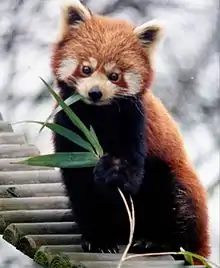

.jpg.webp)

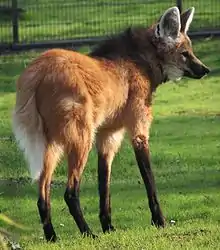

.jpg.webp)
-_rare_sighting_of_this_nocturnal_animal_..._(13799300905).jpg.webp)
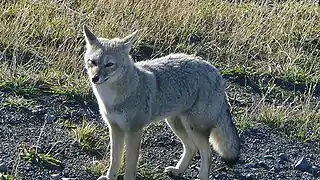
.jpg.webp)
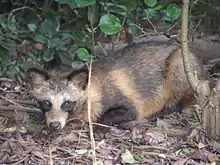

.jpg.webp)
.jpg.webp)
.jpg.webp)

_DSC_0030.jpg.webp)
.jpg.webp)
.jpg.webp)



.jpg.webp)






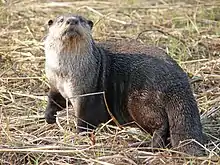
_(25169790524).jpg.webp)



.jpg.webp)





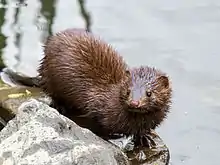
.jpg.webp)
.jpg.webp)
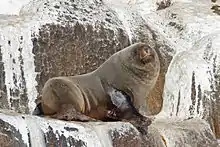
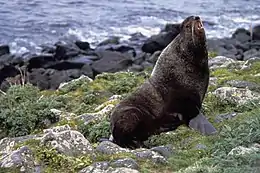
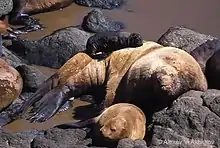




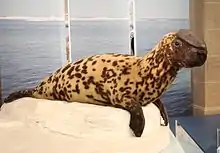
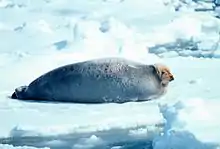

_(cropped).jpg.webp)
_04.jpg.webp)
%E2%80%93Weddell_seal_(Leptonychotes_weddellii)_03.jpg.webp)
.jpg.webp)


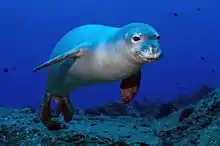

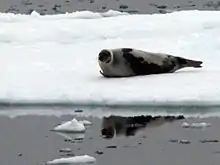
_2.jpg.webp)
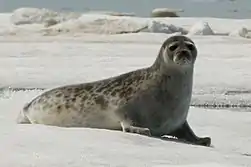




.jpg.webp)


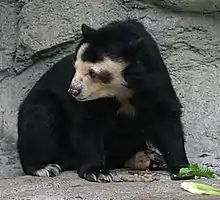
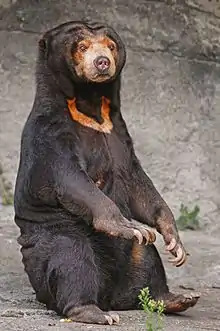




.jpg.webp)
.jpg.webp)


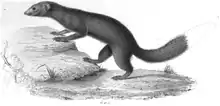
.jpg.webp)
%252C_Paris%252C_d%C3%A9cembre_2013.jpg.webp)



_Zoo_Itatiba.jpg.webp)







.jpg.webp)
.jpg.webp)
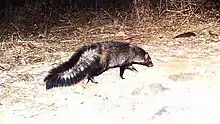
.jpg.webp)

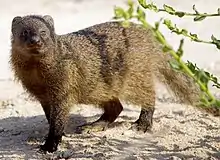
%252C_crop.jpg.webp)



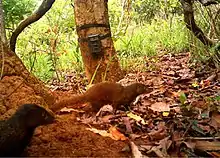
_(6002158282).jpg.webp)

_Tswalu.jpg.webp)
.jpg.webp)


.png.webp)

.JPG.webp)






_(8076736823)_(cut).jpg.webp)
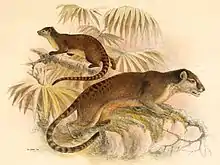
.jpg.webp)



